Improvement Awareness of Safety Enforcement in Construction Industry for SME
VerifiedAdded on 2023/06/14
|27
|8408
|99
AI Summary
The study aims to evaluate the effectiveness of internal enforcement programmes as a method of approach to improve awareness and safety standards within the organization. It reviews the importance of safety awareness in the construction industry, factors influencing awareness, and the application of enforcement strategy at various levels.
Contribute Materials
Your contribution can guide someone’s learning journey. Share your
documents today.
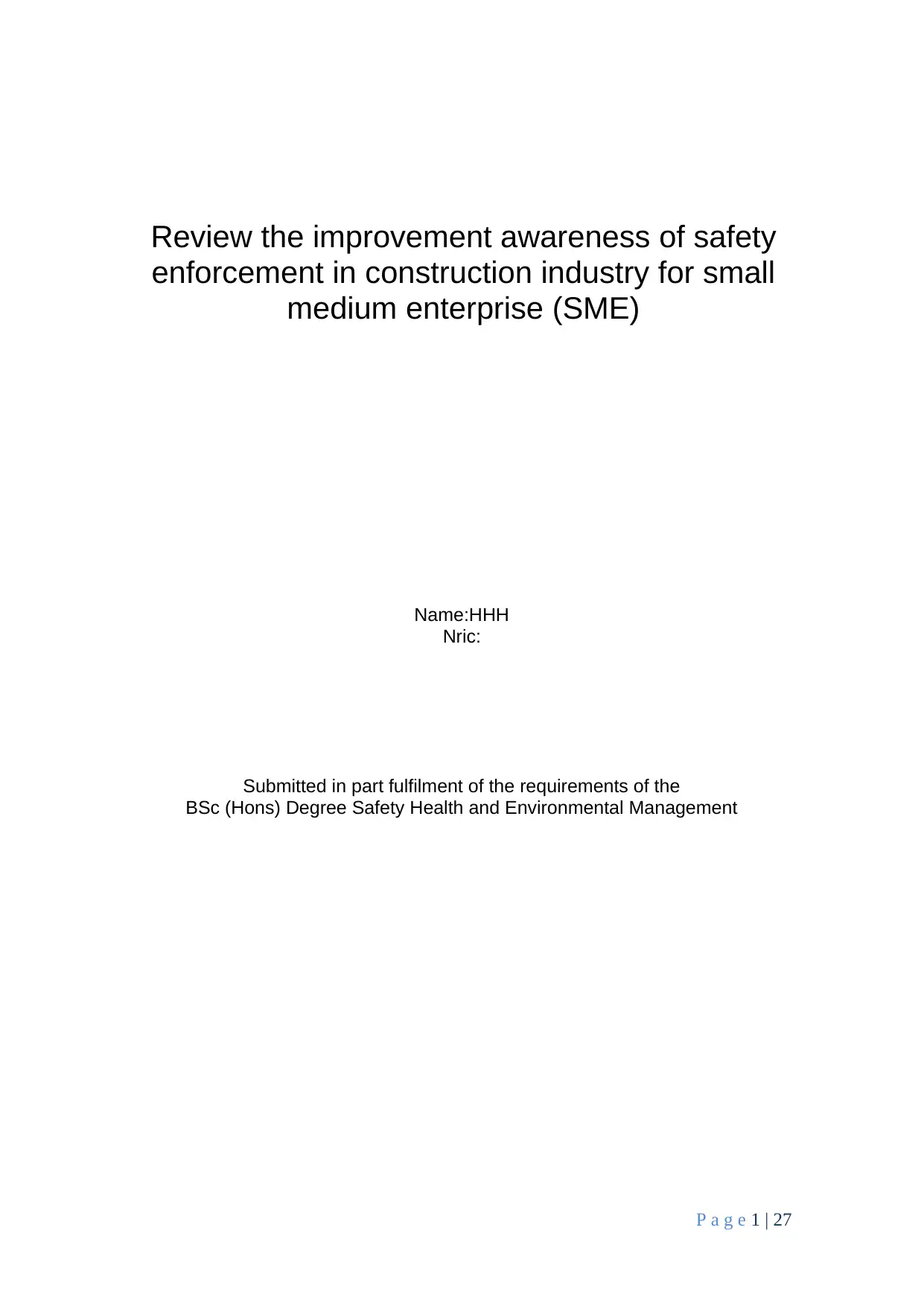
Review the improvement awareness of safety
enforcement in construction industry for small
medium enterprise (SME)
Name:HHH
Nric:
Submitted in part fulfilment of the requirements of the
BSc (Hons) Degree Safety Health and Environmental Management
P a g e 1 | 27
enforcement in construction industry for small
medium enterprise (SME)
Name:HHH
Nric:
Submitted in part fulfilment of the requirements of the
BSc (Hons) Degree Safety Health and Environmental Management
P a g e 1 | 27
Secure Best Marks with AI Grader
Need help grading? Try our AI Grader for instant feedback on your assignments.

Acknowledgement
Firstly, I would like to express my whole-hearted gratitudeto my supervisor Mr
_____________ for all his assistance and guidance for the timely completion of my
honours project. His intuitiveand critical comments are greatly valuable. I am truly
honoured to have him as my mentor who always spares the extra mile to help his
students.
Secondly, I would like to thank my management from ______________ who
approved the research program to be conducted within the organization. Without
them, the genuine approach of the study would not be conclusive to assess the
improvement awareness of enforcement. Special mentioned to Mr Wilson Tan, my
project manager who has permit the study to be carried out while he is aware that it
may affect and somehow cause minor impedance to the progress during the data
collection. All this is made possible with his beliefthat the research may yearn positive
results to continually improve safety. In addition, I am very grateful to Mr
______________WSH manager who has supported me in the data collection
development. I truly appreciate the guidance and assistance from him and his team
of safety coordinators, supervisor who have facilitate the process of obtaining data
from the volunteered workers. Not forgetting the workers and supervisors who
volunteered to be part of the data collection process and gave their full commitment
to determine the accuracy of the data.
Thirdly, ____________________CEO, whom is committed and open to new ideas to
improve the safety culture of his company. His great passion and interest to increase
the safety standards of V3 construction Pte ltd has motivated me to be more focus
and meticulous in the data analysis process. Furthermore, I am greatly honoured
thatthe result of the analysis will be greatly considered as part of the counteraction
program for the annual management review.
Lastly and most importantly to my family, my wife and my 3 sons, who have been
enduring the lack of family timewhile I am juggling my work and studies. Thanks to
them for make this all possible and achievable task for me.
It has been a long yet valuable experience for me.
P a g e 2 | 27
Firstly, I would like to express my whole-hearted gratitudeto my supervisor Mr
_____________ for all his assistance and guidance for the timely completion of my
honours project. His intuitiveand critical comments are greatly valuable. I am truly
honoured to have him as my mentor who always spares the extra mile to help his
students.
Secondly, I would like to thank my management from ______________ who
approved the research program to be conducted within the organization. Without
them, the genuine approach of the study would not be conclusive to assess the
improvement awareness of enforcement. Special mentioned to Mr Wilson Tan, my
project manager who has permit the study to be carried out while he is aware that it
may affect and somehow cause minor impedance to the progress during the data
collection. All this is made possible with his beliefthat the research may yearn positive
results to continually improve safety. In addition, I am very grateful to Mr
______________WSH manager who has supported me in the data collection
development. I truly appreciate the guidance and assistance from him and his team
of safety coordinators, supervisor who have facilitate the process of obtaining data
from the volunteered workers. Not forgetting the workers and supervisors who
volunteered to be part of the data collection process and gave their full commitment
to determine the accuracy of the data.
Thirdly, ____________________CEO, whom is committed and open to new ideas to
improve the safety culture of his company. His great passion and interest to increase
the safety standards of V3 construction Pte ltd has motivated me to be more focus
and meticulous in the data analysis process. Furthermore, I am greatly honoured
thatthe result of the analysis will be greatly considered as part of the counteraction
program for the annual management review.
Lastly and most importantly to my family, my wife and my 3 sons, who have been
enduring the lack of family timewhile I am juggling my work and studies. Thanks to
them for make this all possible and achievable task for me.
It has been a long yet valuable experience for me.
P a g e 2 | 27
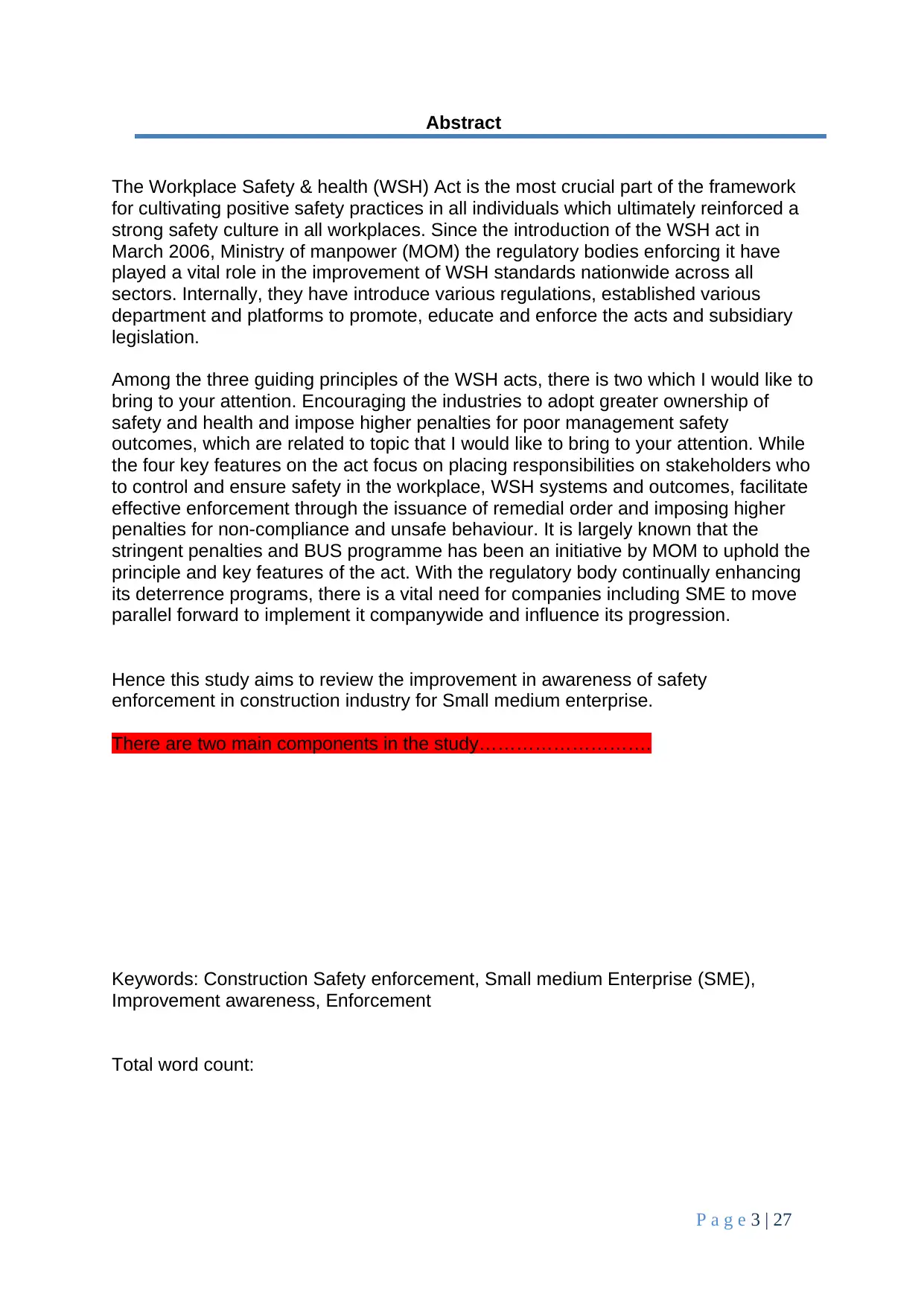
Abstract
The Workplace Safety & health (WSH) Act is the most crucial part of the framework
for cultivating positive safety practices in all individuals which ultimately reinforced a
strong safety culture in all workplaces. Since the introduction of the WSH act in
March 2006, Ministry of manpower (MOM) the regulatory bodies enforcing it have
played a vital role in the improvement of WSH standards nationwide across all
sectors. Internally, they have introduce various regulations, established various
department and platforms to promote, educate and enforce the acts and subsidiary
legislation.
Among the three guiding principles of the WSH acts, there is two which I would like to
bring to your attention. Encouraging the industries to adopt greater ownership of
safety and health and impose higher penalties for poor management safety
outcomes, which are related to topic that I would like to bring to your attention. While
the four key features on the act focus on placing responsibilities on stakeholders who
to control and ensure safety in the workplace, WSH systems and outcomes, facilitate
effective enforcement through the issuance of remedial order and imposing higher
penalties for non-compliance and unsafe behaviour. It is largely known that the
stringent penalties and BUS programme has been an initiative by MOM to uphold the
principle and key features of the act. With the regulatory body continually enhancing
its deterrence programs, there is a vital need for companies including SME to move
parallel forward to implement it companywide and influence its progression.
Hence this study aims to review the improvement in awareness of safety
enforcement in construction industry for Small medium enterprise.
There are two main components in the study……………………….
Keywords: Construction Safety enforcement, Small medium Enterprise (SME),
Improvement awareness, Enforcement
Total word count:
P a g e 3 | 27
The Workplace Safety & health (WSH) Act is the most crucial part of the framework
for cultivating positive safety practices in all individuals which ultimately reinforced a
strong safety culture in all workplaces. Since the introduction of the WSH act in
March 2006, Ministry of manpower (MOM) the regulatory bodies enforcing it have
played a vital role in the improvement of WSH standards nationwide across all
sectors. Internally, they have introduce various regulations, established various
department and platforms to promote, educate and enforce the acts and subsidiary
legislation.
Among the three guiding principles of the WSH acts, there is two which I would like to
bring to your attention. Encouraging the industries to adopt greater ownership of
safety and health and impose higher penalties for poor management safety
outcomes, which are related to topic that I would like to bring to your attention. While
the four key features on the act focus on placing responsibilities on stakeholders who
to control and ensure safety in the workplace, WSH systems and outcomes, facilitate
effective enforcement through the issuance of remedial order and imposing higher
penalties for non-compliance and unsafe behaviour. It is largely known that the
stringent penalties and BUS programme has been an initiative by MOM to uphold the
principle and key features of the act. With the regulatory body continually enhancing
its deterrence programs, there is a vital need for companies including SME to move
parallel forward to implement it companywide and influence its progression.
Hence this study aims to review the improvement in awareness of safety
enforcement in construction industry for Small medium enterprise.
There are two main components in the study……………………….
Keywords: Construction Safety enforcement, Small medium Enterprise (SME),
Improvement awareness, Enforcement
Total word count:
P a g e 3 | 27
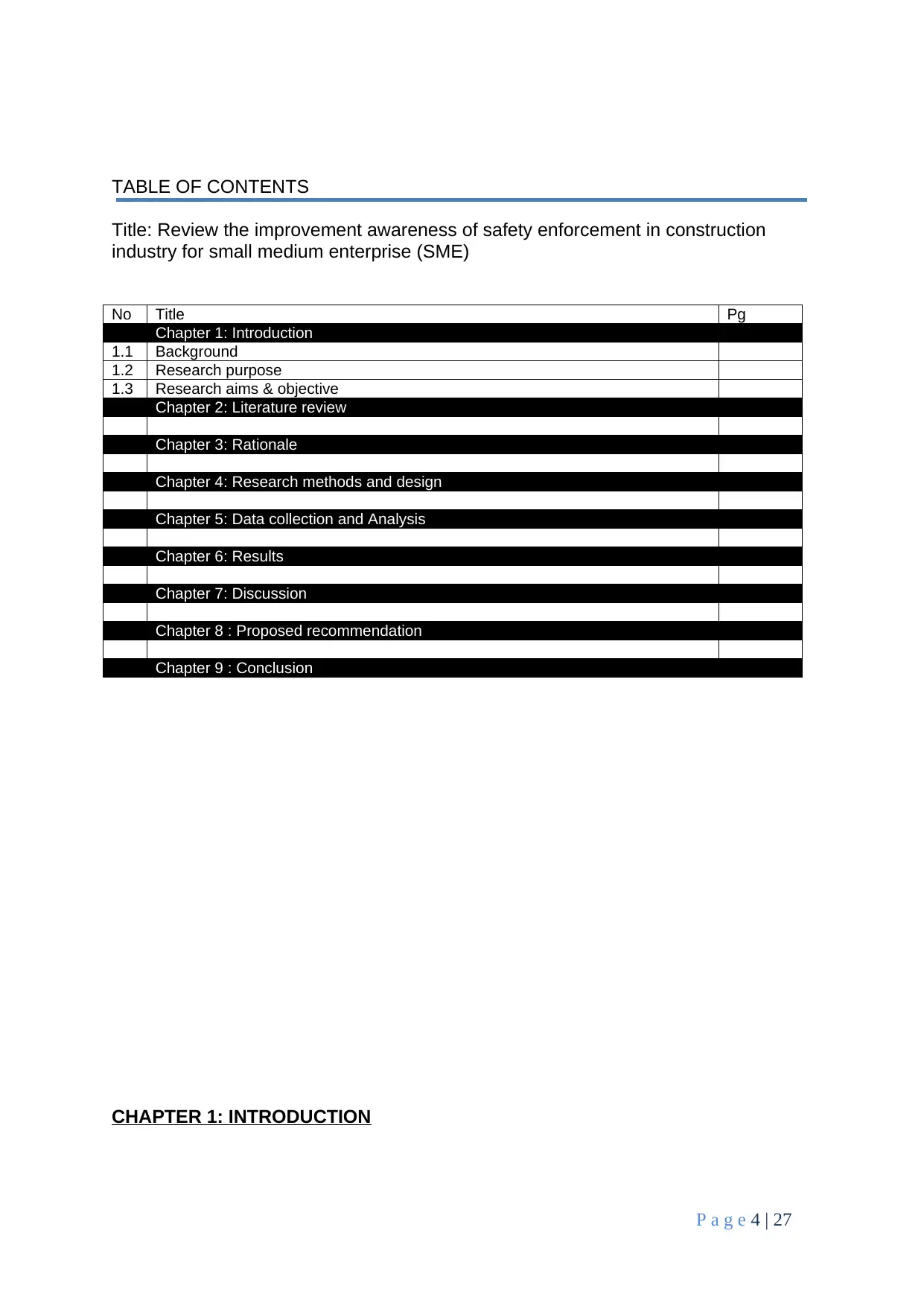
TABLE OF CONTENTS
Title: Review the improvement awareness of safety enforcement in construction
industry for small medium enterprise (SME)
No Title Pg
Chapter 1: Introduction
1.1 Background
1.2 Research purpose
1.3 Research aims & objective
Chapter 2: Literature review
Chapter 3: Rationale
Chapter 4: Research methods and design
Chapter 5: Data collection and Analysis
Chapter 6: Results
Chapter 7: Discussion
Chapter 8 : Proposed recommendation
Chapter 9 : Conclusion
CHAPTER 1: INTRODUCTION
P a g e 4 | 27
Title: Review the improvement awareness of safety enforcement in construction
industry for small medium enterprise (SME)
No Title Pg
Chapter 1: Introduction
1.1 Background
1.2 Research purpose
1.3 Research aims & objective
Chapter 2: Literature review
Chapter 3: Rationale
Chapter 4: Research methods and design
Chapter 5: Data collection and Analysis
Chapter 6: Results
Chapter 7: Discussion
Chapter 8 : Proposed recommendation
Chapter 9 : Conclusion
CHAPTER 1: INTRODUCTION
P a g e 4 | 27
Secure Best Marks with AI Grader
Need help grading? Try our AI Grader for instant feedback on your assignments.
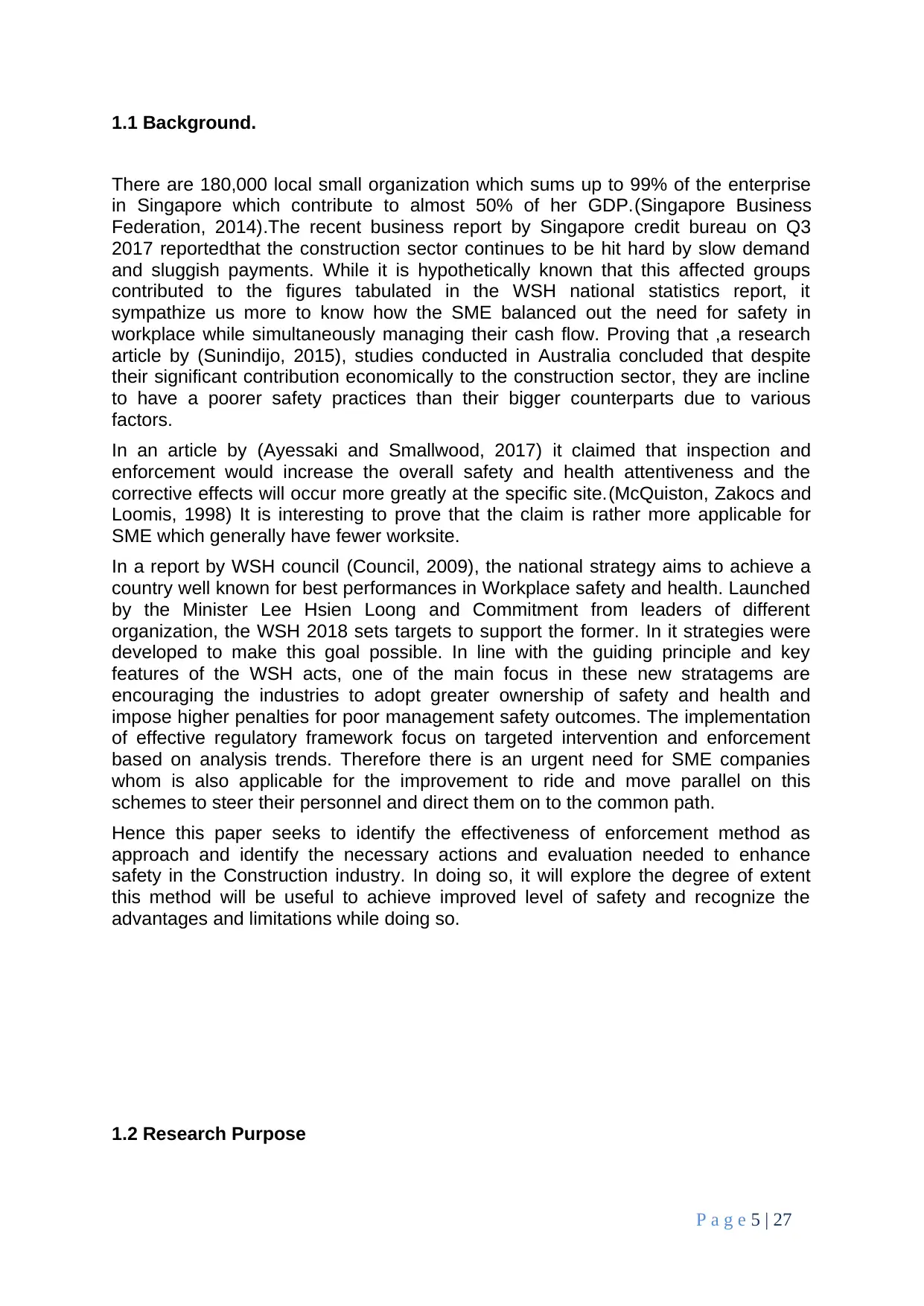
1.1 Background.
There are 180,000 local small organization which sums up to 99% of the enterprise
in Singapore which contribute to almost 50% of her GDP.(Singapore Business
Federation, 2014).The recent business report by Singapore credit bureau on Q3
2017 reportedthat the construction sector continues to be hit hard by slow demand
and sluggish payments. While it is hypothetically known that this affected groups
contributed to the figures tabulated in the WSH national statistics report, it
sympathize us more to know how the SME balanced out the need for safety in
workplace while simultaneously managing their cash flow. Proving that ,a research
article by (Sunindijo, 2015), studies conducted in Australia concluded that despite
their significant contribution economically to the construction sector, they are incline
to have a poorer safety practices than their bigger counterparts due to various
factors.
In an article by (Ayessaki and Smallwood, 2017) it claimed that inspection and
enforcement would increase the overall safety and health attentiveness and the
corrective effects will occur more greatly at the specific site.(McQuiston, Zakocs and
Loomis, 1998) It is interesting to prove that the claim is rather more applicable for
SME which generally have fewer worksite.
In a report by WSH council (Council, 2009), the national strategy aims to achieve a
country well known for best performances in Workplace safety and health. Launched
by the Minister Lee Hsien Loong and Commitment from leaders of different
organization, the WSH 2018 sets targets to support the former. In it strategies were
developed to make this goal possible. In line with the guiding principle and key
features of the WSH acts, one of the main focus in these new stratagems are
encouraging the industries to adopt greater ownership of safety and health and
impose higher penalties for poor management safety outcomes. The implementation
of effective regulatory framework focus on targeted intervention and enforcement
based on analysis trends. Therefore there is an urgent need for SME companies
whom is also applicable for the improvement to ride and move parallel on this
schemes to steer their personnel and direct them on to the common path.
Hence this paper seeks to identify the effectiveness of enforcement method as
approach and identify the necessary actions and evaluation needed to enhance
safety in the Construction industry. In doing so, it will explore the degree of extent
this method will be useful to achieve improved level of safety and recognize the
advantages and limitations while doing so.
1.2 Research Purpose
P a g e 5 | 27
There are 180,000 local small organization which sums up to 99% of the enterprise
in Singapore which contribute to almost 50% of her GDP.(Singapore Business
Federation, 2014).The recent business report by Singapore credit bureau on Q3
2017 reportedthat the construction sector continues to be hit hard by slow demand
and sluggish payments. While it is hypothetically known that this affected groups
contributed to the figures tabulated in the WSH national statistics report, it
sympathize us more to know how the SME balanced out the need for safety in
workplace while simultaneously managing their cash flow. Proving that ,a research
article by (Sunindijo, 2015), studies conducted in Australia concluded that despite
their significant contribution economically to the construction sector, they are incline
to have a poorer safety practices than their bigger counterparts due to various
factors.
In an article by (Ayessaki and Smallwood, 2017) it claimed that inspection and
enforcement would increase the overall safety and health attentiveness and the
corrective effects will occur more greatly at the specific site.(McQuiston, Zakocs and
Loomis, 1998) It is interesting to prove that the claim is rather more applicable for
SME which generally have fewer worksite.
In a report by WSH council (Council, 2009), the national strategy aims to achieve a
country well known for best performances in Workplace safety and health. Launched
by the Minister Lee Hsien Loong and Commitment from leaders of different
organization, the WSH 2018 sets targets to support the former. In it strategies were
developed to make this goal possible. In line with the guiding principle and key
features of the WSH acts, one of the main focus in these new stratagems are
encouraging the industries to adopt greater ownership of safety and health and
impose higher penalties for poor management safety outcomes. The implementation
of effective regulatory framework focus on targeted intervention and enforcement
based on analysis trends. Therefore there is an urgent need for SME companies
whom is also applicable for the improvement to ride and move parallel on this
schemes to steer their personnel and direct them on to the common path.
Hence this paper seeks to identify the effectiveness of enforcement method as
approach and identify the necessary actions and evaluation needed to enhance
safety in the Construction industry. In doing so, it will explore the degree of extent
this method will be useful to achieve improved level of safety and recognize the
advantages and limitations while doing so.
1.2 Research Purpose
P a g e 5 | 27

The statistic reported for workplace fatalities remain stagnant in 2016 with 24
fatalities accounted from the construction industry alone(OSHD annual report 2016,
2016). The figure here raise doubts on the effectiveness of the enforcement action.
While various operations and method had been steered by MOM to increase
awareness and importance of safety, there is still doubts whether this programmes
have reached out to the SME whom theoretically contributed to the ever worrying
trend. The purpose of these research is to review the effectiveness of internal
enforcement programmes as a method of approach to improve awareness and
safety standards within my organization. The result gained will be a point of
reference to continually increase the stringency of safety programmes in my
organization.
1.3 Research aim and objectives
The aim of the study is to determine the effect of enforcement as an action by middle
to top management from my company. It aims to evaluate the awareness when such
programmes is implemented internally.
The objective of this study is to ascertain the efficiency of enforcement as a method
of application to improve awareness in my organization which ultimately aims to
increase WSH standards
At the end of the study, the factual data may be used to justify the need for
enforcement to improve the awareness in the ever dynamic state of construction
industry for SME.
CHAPTER 2: Literature Review
P a g e 6 | 27
fatalities accounted from the construction industry alone(OSHD annual report 2016,
2016). The figure here raise doubts on the effectiveness of the enforcement action.
While various operations and method had been steered by MOM to increase
awareness and importance of safety, there is still doubts whether this programmes
have reached out to the SME whom theoretically contributed to the ever worrying
trend. The purpose of these research is to review the effectiveness of internal
enforcement programmes as a method of approach to improve awareness and
safety standards within my organization. The result gained will be a point of
reference to continually increase the stringency of safety programmes in my
organization.
1.3 Research aim and objectives
The aim of the study is to determine the effect of enforcement as an action by middle
to top management from my company. It aims to evaluate the awareness when such
programmes is implemented internally.
The objective of this study is to ascertain the efficiency of enforcement as a method
of application to improve awareness in my organization which ultimately aims to
increase WSH standards
At the end of the study, the factual data may be used to justify the need for
enforcement to improve the awareness in the ever dynamic state of construction
industry for SME.
CHAPTER 2: Literature Review
P a g e 6 | 27
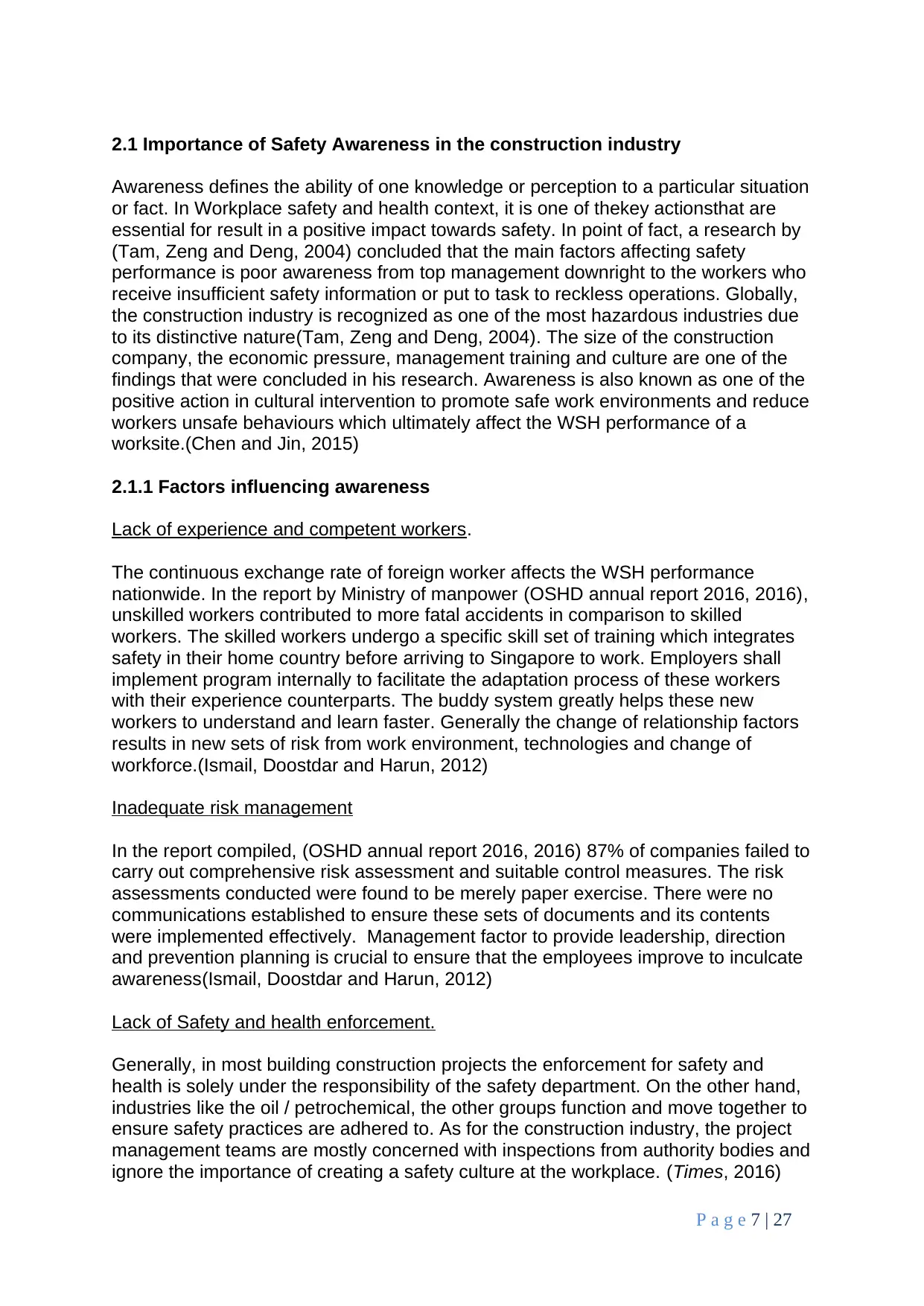
2.1 Importance of Safety Awareness in the construction industry
Awareness defines the ability of one knowledge or perception to a particular situation
or fact. In Workplace safety and health context, it is one of thekey actionsthat are
essential for result in a positive impact towards safety. In point of fact, a research by
(Tam, Zeng and Deng, 2004) concluded that the main factors affecting safety
performance is poor awareness from top management downright to the workers who
receive insufficient safety information or put to task to reckless operations. Globally,
the construction industry is recognized as one of the most hazardous industries due
to its distinctive nature(Tam, Zeng and Deng, 2004). The size of the construction
company, the economic pressure, management training and culture are one of the
findings that were concluded in his research. Awareness is also known as one of the
positive action in cultural intervention to promote safe work environments and reduce
workers unsafe behaviours which ultimately affect the WSH performance of a
worksite.(Chen and Jin, 2015)
2.1.1 Factors influencing awareness
Lack of experience and competent workers.
The continuous exchange rate of foreign worker affects the WSH performance
nationwide. In the report by Ministry of manpower (OSHD annual report 2016, 2016),
unskilled workers contributed to more fatal accidents in comparison to skilled
workers. The skilled workers undergo a specific skill set of training which integrates
safety in their home country before arriving to Singapore to work. Employers shall
implement program internally to facilitate the adaptation process of these workers
with their experience counterparts. The buddy system greatly helps these new
workers to understand and learn faster. Generally the change of relationship factors
results in new sets of risk from work environment, technologies and change of
workforce.(Ismail, Doostdar and Harun, 2012)
Inadequate risk management
In the report compiled, (OSHD annual report 2016, 2016) 87% of companies failed to
carry out comprehensive risk assessment and suitable control measures. The risk
assessments conducted were found to be merely paper exercise. There were no
communications established to ensure these sets of documents and its contents
were implemented effectively. Management factor to provide leadership, direction
and prevention planning is crucial to ensure that the employees improve to inculcate
awareness(Ismail, Doostdar and Harun, 2012)
Lack of Safety and health enforcement.
Generally, in most building construction projects the enforcement for safety and
health is solely under the responsibility of the safety department. On the other hand,
industries like the oil / petrochemical, the other groups function and move together to
ensure safety practices are adhered to. As for the construction industry, the project
management teams are mostly concerned with inspections from authority bodies and
ignore the importance of creating a safety culture at the workplace. (Times, 2016)
P a g e 7 | 27
Awareness defines the ability of one knowledge or perception to a particular situation
or fact. In Workplace safety and health context, it is one of thekey actionsthat are
essential for result in a positive impact towards safety. In point of fact, a research by
(Tam, Zeng and Deng, 2004) concluded that the main factors affecting safety
performance is poor awareness from top management downright to the workers who
receive insufficient safety information or put to task to reckless operations. Globally,
the construction industry is recognized as one of the most hazardous industries due
to its distinctive nature(Tam, Zeng and Deng, 2004). The size of the construction
company, the economic pressure, management training and culture are one of the
findings that were concluded in his research. Awareness is also known as one of the
positive action in cultural intervention to promote safe work environments and reduce
workers unsafe behaviours which ultimately affect the WSH performance of a
worksite.(Chen and Jin, 2015)
2.1.1 Factors influencing awareness
Lack of experience and competent workers.
The continuous exchange rate of foreign worker affects the WSH performance
nationwide. In the report by Ministry of manpower (OSHD annual report 2016, 2016),
unskilled workers contributed to more fatal accidents in comparison to skilled
workers. The skilled workers undergo a specific skill set of training which integrates
safety in their home country before arriving to Singapore to work. Employers shall
implement program internally to facilitate the adaptation process of these workers
with their experience counterparts. The buddy system greatly helps these new
workers to understand and learn faster. Generally the change of relationship factors
results in new sets of risk from work environment, technologies and change of
workforce.(Ismail, Doostdar and Harun, 2012)
Inadequate risk management
In the report compiled, (OSHD annual report 2016, 2016) 87% of companies failed to
carry out comprehensive risk assessment and suitable control measures. The risk
assessments conducted were found to be merely paper exercise. There were no
communications established to ensure these sets of documents and its contents
were implemented effectively. Management factor to provide leadership, direction
and prevention planning is crucial to ensure that the employees improve to inculcate
awareness(Ismail, Doostdar and Harun, 2012)
Lack of Safety and health enforcement.
Generally, in most building construction projects the enforcement for safety and
health is solely under the responsibility of the safety department. On the other hand,
industries like the oil / petrochemical, the other groups function and move together to
ensure safety practices are adhered to. As for the construction industry, the project
management teams are mostly concerned with inspections from authority bodies and
ignore the importance of creating a safety culture at the workplace. (Times, 2016)
P a g e 7 | 27
Paraphrase This Document
Need a fresh take? Get an instant paraphrase of this document with our AI Paraphraser
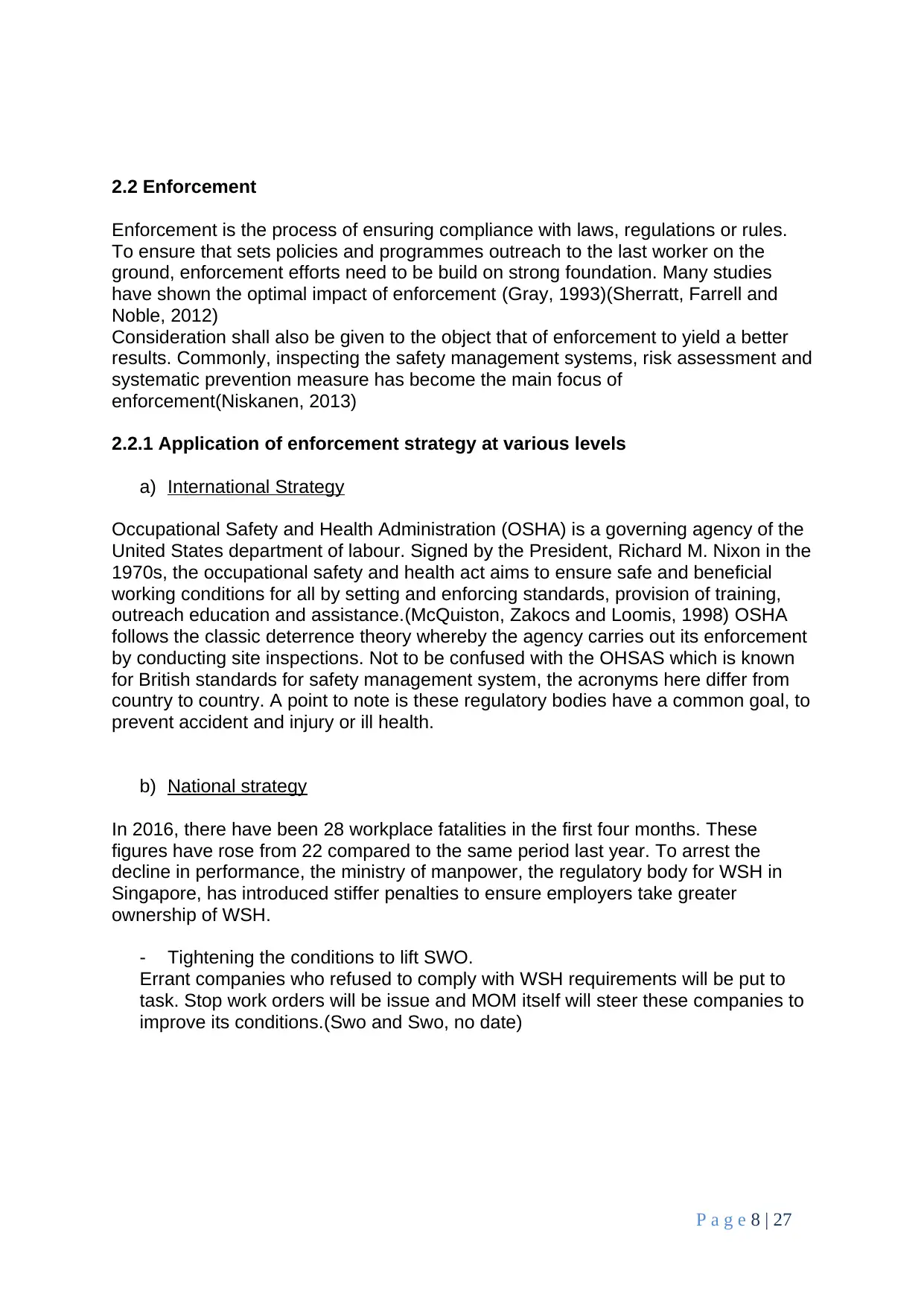
2.2 Enforcement
Enforcement is the process of ensuring compliance with laws, regulations or rules.
To ensure that sets policies and programmes outreach to the last worker on the
ground, enforcement efforts need to be build on strong foundation. Many studies
have shown the optimal impact of enforcement (Gray, 1993)(Sherratt, Farrell and
Noble, 2012)
Consideration shall also be given to the object that of enforcement to yield a better
results. Commonly, inspecting the safety management systems, risk assessment and
systematic prevention measure has become the main focus of
enforcement(Niskanen, 2013)
2.2.1 Application of enforcement strategy at various levels
a) International Strategy
Occupational Safety and Health Administration (OSHA) is a governing agency of the
United States department of labour. Signed by the President, Richard M. Nixon in the
1970s, the occupational safety and health act aims to ensure safe and beneficial
working conditions for all by setting and enforcing standards, provision of training,
outreach education and assistance.(McQuiston, Zakocs and Loomis, 1998) OSHA
follows the classic deterrence theory whereby the agency carries out its enforcement
by conducting site inspections. Not to be confused with the OHSAS which is known
for British standards for safety management system, the acronyms here differ from
country to country. A point to note is these regulatory bodies have a common goal, to
prevent accident and injury or ill health.
b) National strategy
In 2016, there have been 28 workplace fatalities in the first four months. These
figures have rose from 22 compared to the same period last year. To arrest the
decline in performance, the ministry of manpower, the regulatory body for WSH in
Singapore, has introduced stiffer penalties to ensure employers take greater
ownership of WSH.
- Tightening the conditions to lift SWO.
Errant companies who refused to comply with WSH requirements will be put to
task. Stop work orders will be issue and MOM itself will steer these companies to
improve its conditions.(Swo and Swo, no date)
P a g e 8 | 27
Enforcement is the process of ensuring compliance with laws, regulations or rules.
To ensure that sets policies and programmes outreach to the last worker on the
ground, enforcement efforts need to be build on strong foundation. Many studies
have shown the optimal impact of enforcement (Gray, 1993)(Sherratt, Farrell and
Noble, 2012)
Consideration shall also be given to the object that of enforcement to yield a better
results. Commonly, inspecting the safety management systems, risk assessment and
systematic prevention measure has become the main focus of
enforcement(Niskanen, 2013)
2.2.1 Application of enforcement strategy at various levels
a) International Strategy
Occupational Safety and Health Administration (OSHA) is a governing agency of the
United States department of labour. Signed by the President, Richard M. Nixon in the
1970s, the occupational safety and health act aims to ensure safe and beneficial
working conditions for all by setting and enforcing standards, provision of training,
outreach education and assistance.(McQuiston, Zakocs and Loomis, 1998) OSHA
follows the classic deterrence theory whereby the agency carries out its enforcement
by conducting site inspections. Not to be confused with the OHSAS which is known
for British standards for safety management system, the acronyms here differ from
country to country. A point to note is these regulatory bodies have a common goal, to
prevent accident and injury or ill health.
b) National strategy
In 2016, there have been 28 workplace fatalities in the first four months. These
figures have rose from 22 compared to the same period last year. To arrest the
decline in performance, the ministry of manpower, the regulatory body for WSH in
Singapore, has introduced stiffer penalties to ensure employers take greater
ownership of WSH.
- Tightening the conditions to lift SWO.
Errant companies who refused to comply with WSH requirements will be put to
task. Stop work orders will be issue and MOM itself will steer these companies to
improve its conditions.(Swo and Swo, no date)
P a g e 8 | 27
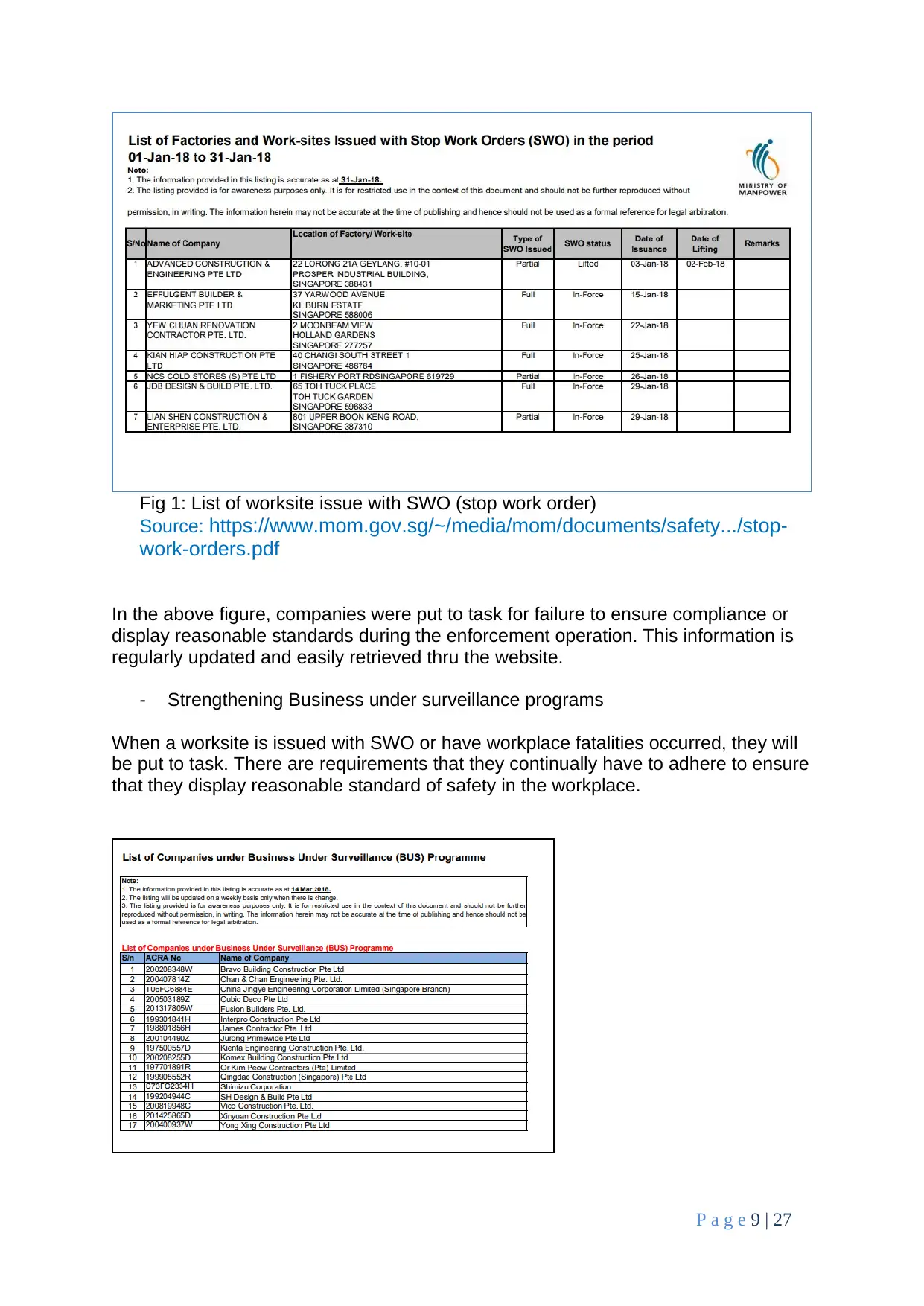
Fig 1: List of worksite issue with SWO (stop work order)
Source: https://www.mom.gov.sg/~/media/mom/documents/safety.../stop-
work-orders.pdf
In the above figure, companies were put to task for failure to ensure compliance or
display reasonable standards during the enforcement operation. This information is
regularly updated and easily retrieved thru the website.
- Strengthening Business under surveillance programs
When a worksite is issued with SWO or have workplace fatalities occurred, they will
be put to task. There are requirements that they continually have to adhere to ensure
that they display reasonable standard of safety in the workplace.
P a g e 9 | 27
Source: https://www.mom.gov.sg/~/media/mom/documents/safety.../stop-
work-orders.pdf
In the above figure, companies were put to task for failure to ensure compliance or
display reasonable standards during the enforcement operation. This information is
regularly updated and easily retrieved thru the website.
- Strengthening Business under surveillance programs
When a worksite is issued with SWO or have workplace fatalities occurred, they will
be put to task. There are requirements that they continually have to adhere to ensure
that they display reasonable standard of safety in the workplace.
P a g e 9 | 27
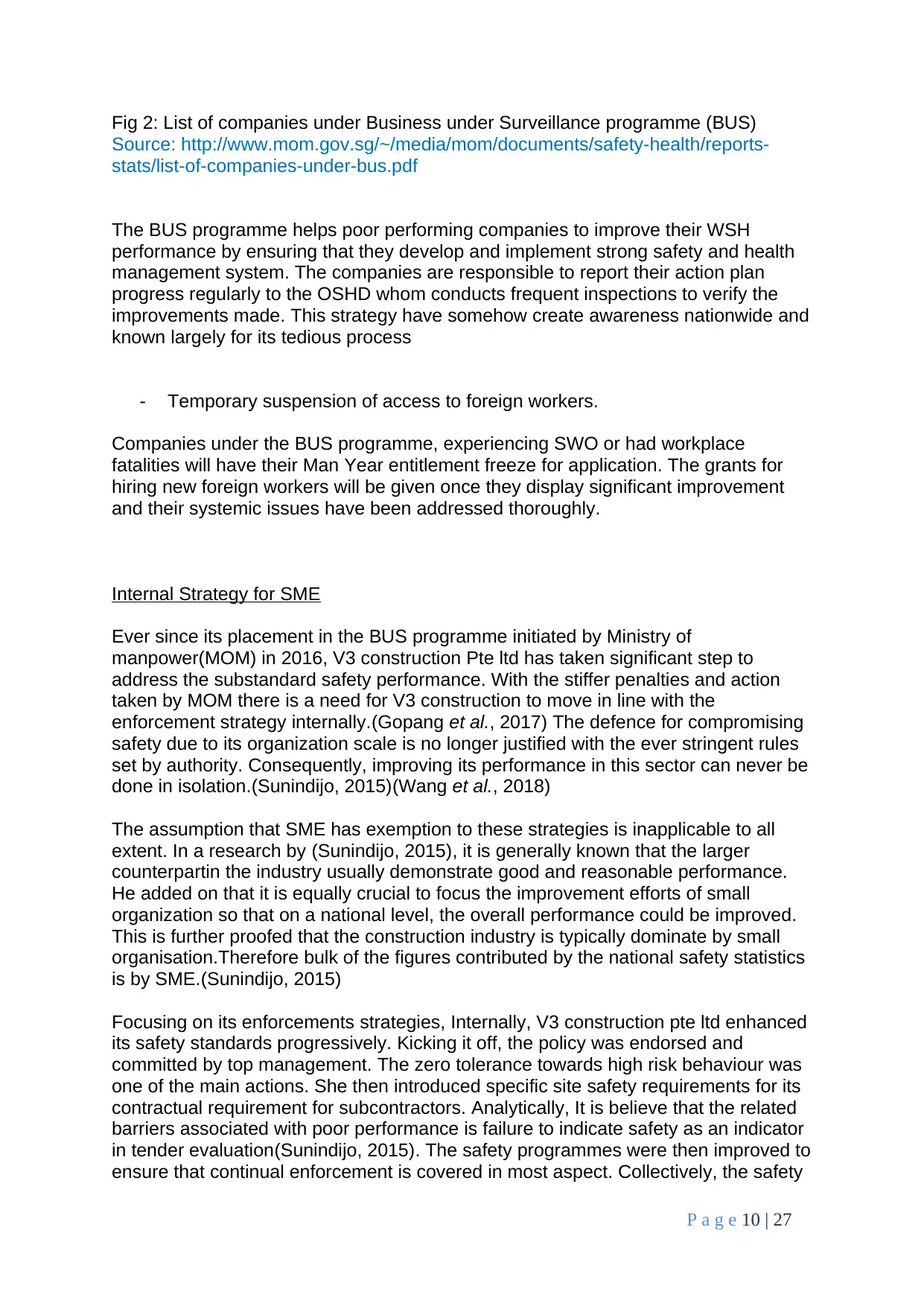
Fig 2: List of companies under Business under Surveillance programme (BUS)
Source: http://www.mom.gov.sg/~/media/mom/documents/safety-health/reports-
stats/list-of-companies-under-bus.pdf
The BUS programme helps poor performing companies to improve their WSH
performance by ensuring that they develop and implement strong safety and health
management system. The companies are responsible to report their action plan
progress regularly to the OSHD whom conducts frequent inspections to verify the
improvements made. This strategy have somehow create awareness nationwide and
known largely for its tedious process
- Temporary suspension of access to foreign workers.
Companies under the BUS programme, experiencing SWO or had workplace
fatalities will have their Man Year entitlement freeze for application. The grants for
hiring new foreign workers will be given once they display significant improvement
and their systemic issues have been addressed thoroughly.
Internal Strategy for SME
Ever since its placement in the BUS programme initiated by Ministry of
manpower(MOM) in 2016, V3 construction Pte ltd has taken significant step to
address the substandard safety performance. With the stiffer penalties and action
taken by MOM there is a need for V3 construction to move in line with the
enforcement strategy internally.(Gopang et al., 2017) The defence for compromising
safety due to its organization scale is no longer justified with the ever stringent rules
set by authority. Consequently, improving its performance in this sector can never be
done in isolation.(Sunindijo, 2015)(Wang et al., 2018)
The assumption that SME has exemption to these strategies is inapplicable to all
extent. In a research by (Sunindijo, 2015), it is generally known that the larger
counterpartin the industry usually demonstrate good and reasonable performance.
He added on that it is equally crucial to focus the improvement efforts of small
organization so that on a national level, the overall performance could be improved.
This is further proofed that the construction industry is typically dominate by small
organisation.Therefore bulk of the figures contributed by the national safety statistics
is by SME.(Sunindijo, 2015)
Focusing on its enforcements strategies, Internally, V3 construction pte ltd enhanced
its safety standards progressively. Kicking it off, the policy was endorsed and
committed by top management. The zero tolerance towards high risk behaviour was
one of the main actions. She then introduced specific site safety requirements for its
contractual requirement for subcontractors. Analytically, It is believe that the related
barriers associated with poor performance is failure to indicate safety as an indicator
in tender evaluation(Sunindijo, 2015). The safety programmes were then improved to
ensure that continual enforcement is covered in most aspect. Collectively, the safety
P a g e 10 | 27
Source: http://www.mom.gov.sg/~/media/mom/documents/safety-health/reports-
stats/list-of-companies-under-bus.pdf
The BUS programme helps poor performing companies to improve their WSH
performance by ensuring that they develop and implement strong safety and health
management system. The companies are responsible to report their action plan
progress regularly to the OSHD whom conducts frequent inspections to verify the
improvements made. This strategy have somehow create awareness nationwide and
known largely for its tedious process
- Temporary suspension of access to foreign workers.
Companies under the BUS programme, experiencing SWO or had workplace
fatalities will have their Man Year entitlement freeze for application. The grants for
hiring new foreign workers will be given once they display significant improvement
and their systemic issues have been addressed thoroughly.
Internal Strategy for SME
Ever since its placement in the BUS programme initiated by Ministry of
manpower(MOM) in 2016, V3 construction Pte ltd has taken significant step to
address the substandard safety performance. With the stiffer penalties and action
taken by MOM there is a need for V3 construction to move in line with the
enforcement strategy internally.(Gopang et al., 2017) The defence for compromising
safety due to its organization scale is no longer justified with the ever stringent rules
set by authority. Consequently, improving its performance in this sector can never be
done in isolation.(Sunindijo, 2015)(Wang et al., 2018)
The assumption that SME has exemption to these strategies is inapplicable to all
extent. In a research by (Sunindijo, 2015), it is generally known that the larger
counterpartin the industry usually demonstrate good and reasonable performance.
He added on that it is equally crucial to focus the improvement efforts of small
organization so that on a national level, the overall performance could be improved.
This is further proofed that the construction industry is typically dominate by small
organisation.Therefore bulk of the figures contributed by the national safety statistics
is by SME.(Sunindijo, 2015)
Focusing on its enforcements strategies, Internally, V3 construction pte ltd enhanced
its safety standards progressively. Kicking it off, the policy was endorsed and
committed by top management. The zero tolerance towards high risk behaviour was
one of the main actions. She then introduced specific site safety requirements for its
contractual requirement for subcontractors. Analytically, It is believe that the related
barriers associated with poor performance is failure to indicate safety as an indicator
in tender evaluation(Sunindijo, 2015). The safety programmes were then improved to
ensure that continual enforcement is covered in most aspect. Collectively, the safety
P a g e 10 | 27
Secure Best Marks with AI Grader
Need help grading? Try our AI Grader for instant feedback on your assignments.
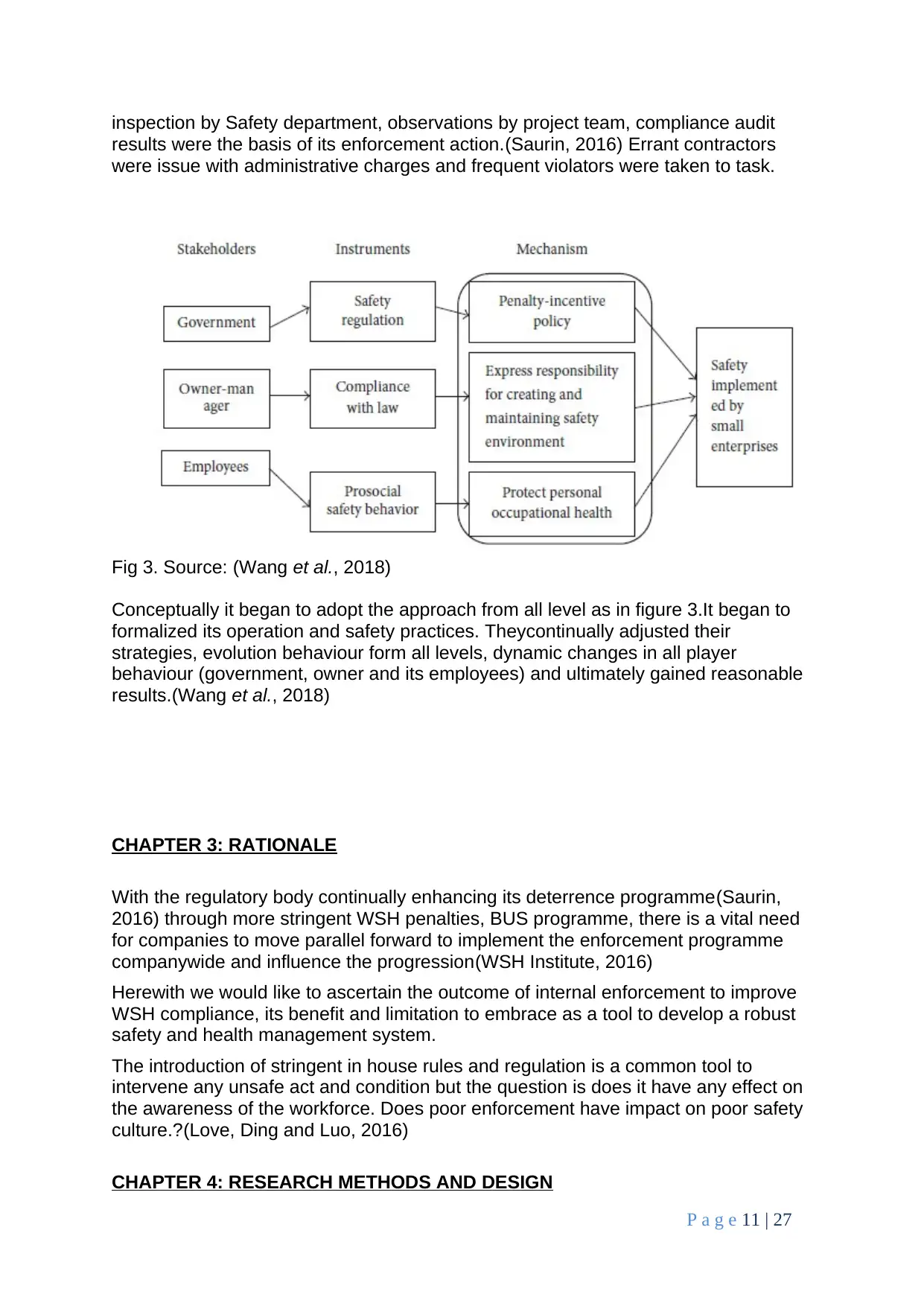
inspection by Safety department, observations by project team, compliance audit
results were the basis of its enforcement action.(Saurin, 2016) Errant contractors
were issue with administrative charges and frequent violators were taken to task.
Fig 3. Source: (Wang et al., 2018)
Conceptually it began to adopt the approach from all level as in figure 3.It began to
formalized its operation and safety practices. Theycontinually adjusted their
strategies, evolution behaviour form all levels, dynamic changes in all player
behaviour (government, owner and its employees) and ultimately gained reasonable
results.(Wang et al., 2018)
CHAPTER 3: RATIONALE
With the regulatory body continually enhancing its deterrence programme(Saurin,
2016) through more stringent WSH penalties, BUS programme, there is a vital need
for companies to move parallel forward to implement the enforcement programme
companywide and influence the progression(WSH Institute, 2016)
Herewith we would like to ascertain the outcome of internal enforcement to improve
WSH compliance, its benefit and limitation to embrace as a tool to develop a robust
safety and health management system.
The introduction of stringent in house rules and regulation is a common tool to
intervene any unsafe act and condition but the question is does it have any effect on
the awareness of the workforce. Does poor enforcement have impact on poor safety
culture.?(Love, Ding and Luo, 2016)
CHAPTER 4: RESEARCH METHODS AND DESIGN
P a g e 11 | 27
results were the basis of its enforcement action.(Saurin, 2016) Errant contractors
were issue with administrative charges and frequent violators were taken to task.
Fig 3. Source: (Wang et al., 2018)
Conceptually it began to adopt the approach from all level as in figure 3.It began to
formalized its operation and safety practices. Theycontinually adjusted their
strategies, evolution behaviour form all levels, dynamic changes in all player
behaviour (government, owner and its employees) and ultimately gained reasonable
results.(Wang et al., 2018)
CHAPTER 3: RATIONALE
With the regulatory body continually enhancing its deterrence programme(Saurin,
2016) through more stringent WSH penalties, BUS programme, there is a vital need
for companies to move parallel forward to implement the enforcement programme
companywide and influence the progression(WSH Institute, 2016)
Herewith we would like to ascertain the outcome of internal enforcement to improve
WSH compliance, its benefit and limitation to embrace as a tool to develop a robust
safety and health management system.
The introduction of stringent in house rules and regulation is a common tool to
intervene any unsafe act and condition but the question is does it have any effect on
the awareness of the workforce. Does poor enforcement have impact on poor safety
culture.?(Love, Ding and Luo, 2016)
CHAPTER 4: RESEARCH METHODS AND DESIGN
P a g e 11 | 27
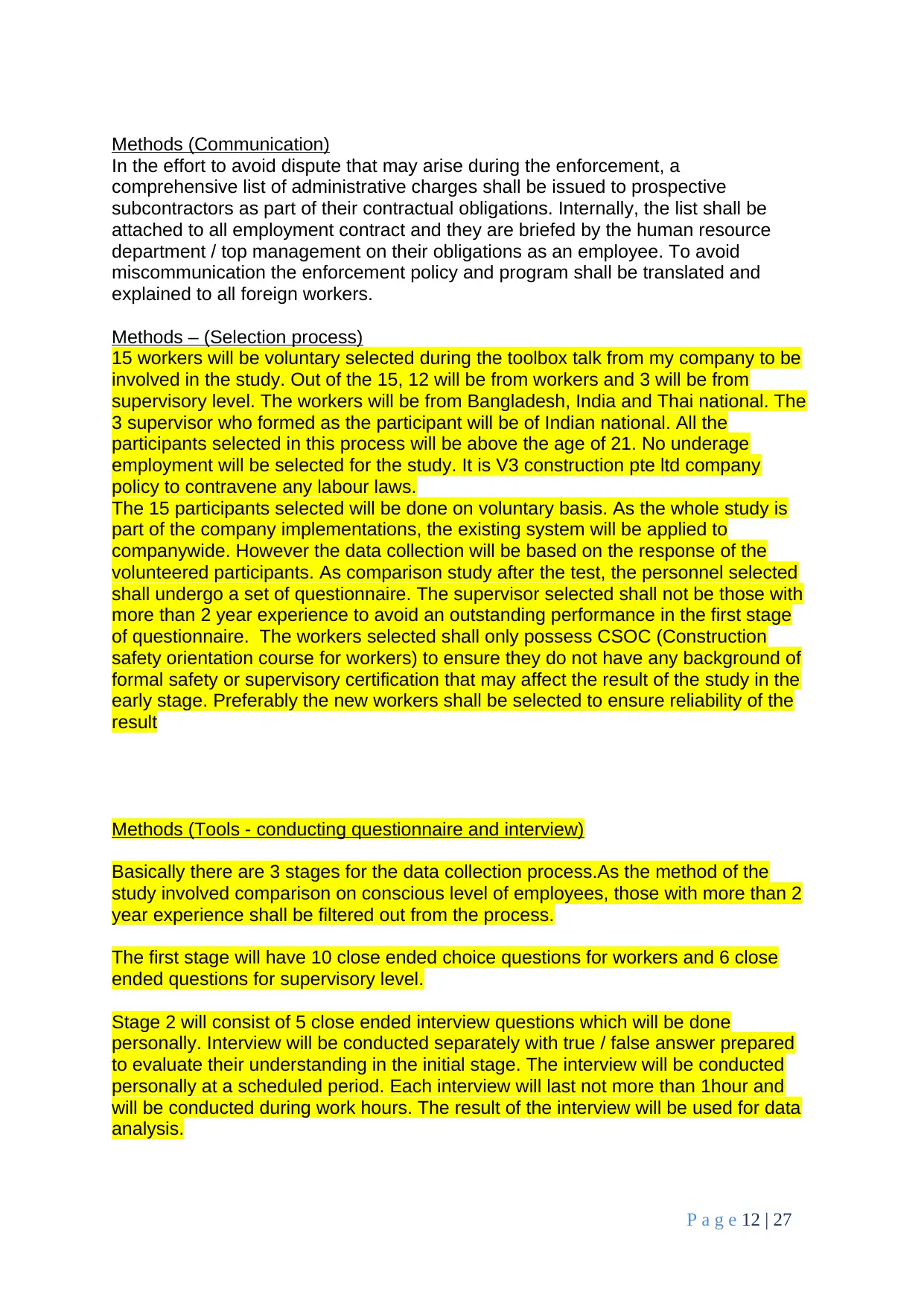
Methods (Communication)
In the effort to avoid dispute that may arise during the enforcement, a
comprehensive list of administrative charges shall be issued to prospective
subcontractors as part of their contractual obligations. Internally, the list shall be
attached to all employment contract and they are briefed by the human resource
department / top management on their obligations as an employee. To avoid
miscommunication the enforcement policy and program shall be translated and
explained to all foreign workers.
Methods – (Selection process)
15 workers will be voluntary selected during the toolbox talk from my company to be
involved in the study. Out of the 15, 12 will be from workers and 3 will be from
supervisory level. The workers will be from Bangladesh, India and Thai national. The
3 supervisor who formed as the participant will be of Indian national. All the
participants selected in this process will be above the age of 21. No underage
employment will be selected for the study. It is V3 construction pte ltd company
policy to contravene any labour laws.
The 15 participants selected will be done on voluntary basis. As the whole study is
part of the company implementations, the existing system will be applied to
companywide. However the data collection will be based on the response of the
volunteered participants. As comparison study after the test, the personnel selected
shall undergo a set of questionnaire. The supervisor selected shall not be those with
more than 2 year experience to avoid an outstanding performance in the first stage
of questionnaire. The workers selected shall only possess CSOC (Construction
safety orientation course for workers) to ensure they do not have any background of
formal safety or supervisory certification that may affect the result of the study in the
early stage. Preferably the new workers shall be selected to ensure reliability of the
result
Methods (Tools - conducting questionnaire and interview)
Basically there are 3 stages for the data collection process.As the method of the
study involved comparison on conscious level of employees, those with more than 2
year experience shall be filtered out from the process.
The first stage will have 10 close ended choice questions for workers and 6 close
ended questions for supervisory level.
Stage 2 will consist of 5 close ended interview questions which will be done
personally. Interview will be conducted separately with true / false answer prepared
to evaluate their understanding in the initial stage. The interview will be conducted
personally at a scheduled period. Each interview will last not more than 1hour and
will be conducted during work hours. The result of the interview will be used for data
analysis.
P a g e 12 | 27
In the effort to avoid dispute that may arise during the enforcement, a
comprehensive list of administrative charges shall be issued to prospective
subcontractors as part of their contractual obligations. Internally, the list shall be
attached to all employment contract and they are briefed by the human resource
department / top management on their obligations as an employee. To avoid
miscommunication the enforcement policy and program shall be translated and
explained to all foreign workers.
Methods – (Selection process)
15 workers will be voluntary selected during the toolbox talk from my company to be
involved in the study. Out of the 15, 12 will be from workers and 3 will be from
supervisory level. The workers will be from Bangladesh, India and Thai national. The
3 supervisor who formed as the participant will be of Indian national. All the
participants selected in this process will be above the age of 21. No underage
employment will be selected for the study. It is V3 construction pte ltd company
policy to contravene any labour laws.
The 15 participants selected will be done on voluntary basis. As the whole study is
part of the company implementations, the existing system will be applied to
companywide. However the data collection will be based on the response of the
volunteered participants. As comparison study after the test, the personnel selected
shall undergo a set of questionnaire. The supervisor selected shall not be those with
more than 2 year experience to avoid an outstanding performance in the first stage
of questionnaire. The workers selected shall only possess CSOC (Construction
safety orientation course for workers) to ensure they do not have any background of
formal safety or supervisory certification that may affect the result of the study in the
early stage. Preferably the new workers shall be selected to ensure reliability of the
result
Methods (Tools - conducting questionnaire and interview)
Basically there are 3 stages for the data collection process.As the method of the
study involved comparison on conscious level of employees, those with more than 2
year experience shall be filtered out from the process.
The first stage will have 10 close ended choice questions for workers and 6 close
ended questions for supervisory level.
Stage 2 will consist of 5 close ended interview questions which will be done
personally. Interview will be conducted separately with true / false answer prepared
to evaluate their understanding in the initial stage. The interview will be conducted
personally at a scheduled period. Each interview will last not more than 1hour and
will be conducted during work hours. The result of the interview will be used for data
analysis.
P a g e 12 | 27

Stage 3 consist of 2 parts, the same multiple choice questions and interview
question will be tested for both workers and supervisors repeatedly after
enforcement action is carried out. The result collected from this part will be used as a
comparison against stage 2 to evaluate the performance.
Due to limitation of time(Ayessaki and Smallwood, 2017), the type of questionnaire
and interview posed will be focusing on the 4 main type of hazard that is reported in
the national statistics for the construction industry. Naming Fall from height, Struck
by moving object, struck by falling object and crane related which accounts for 75%
of the fatalities in the construction industry in year 2016 (WSH Institute, 2016)
Methods – (Execution of test - enforcement action)
At the beginning all the subject will undergo a comprehensive refresher safety
induction course with emphasis on the new enforcement programme introduced after
the 2 stagesof questionnaire and interview respectively. Then time frame will be set
of which different types of enforcement program will be introduced. Of which
scheduled general site inspection, surprise safety inspection, document review and
dedicated safety inspection will be carried out. Special attention will be given to
personnel subjected for the test to increase their awareness during the specified
period
Methods – Evaluating awareness after enforcement action.
After 3 months of continual enforcement action the similar sets of question will be
given to the subject to evaluate their awareness improvement level.(stage 3)
Methods – (Data collection & analysis)
The stage 3 questionnaire and interview will be used for data comparison against the
first 2 stage. After which analysis will be carried out on the performance and
awareness level after the period of enforcement. The result from both the study will
be analysed in as system based software. The result of the study will be considered
for improvement and shared with the management only.
CHAPTER 5: DATA COLLECTION AND ANALYSIS
The data collection process has been undertaken in order to have an idea about the
answers that is desired in accordance to this research topic. The data has been
collected with the help of questionnaire survey and interview and the process has
been segmented into three different stages.
The main reason for segmenting the data collection and analysis process is to have
an understanding about the pre and post reactions of the respondents after the
enforcement have been taken in the system. The data that has been collected from
workers and the supervisors separately and the questions that have been asked for
them can be divided on multiple choices to understand the idea of awareness.
The pre-assessment (stage 1) questions that have been asked to the selected
workers have indicated that as a whole the workers are not satisfied with all the
processes and the policies that are existent within the organization. Moreover, their
awareness regarding the safety issues in construction is to be dealt with their
understanding. The questions that have been provided to the workers are all close
P a g e 13 | 27
question will be tested for both workers and supervisors repeatedly after
enforcement action is carried out. The result collected from this part will be used as a
comparison against stage 2 to evaluate the performance.
Due to limitation of time(Ayessaki and Smallwood, 2017), the type of questionnaire
and interview posed will be focusing on the 4 main type of hazard that is reported in
the national statistics for the construction industry. Naming Fall from height, Struck
by moving object, struck by falling object and crane related which accounts for 75%
of the fatalities in the construction industry in year 2016 (WSH Institute, 2016)
Methods – (Execution of test - enforcement action)
At the beginning all the subject will undergo a comprehensive refresher safety
induction course with emphasis on the new enforcement programme introduced after
the 2 stagesof questionnaire and interview respectively. Then time frame will be set
of which different types of enforcement program will be introduced. Of which
scheduled general site inspection, surprise safety inspection, document review and
dedicated safety inspection will be carried out. Special attention will be given to
personnel subjected for the test to increase their awareness during the specified
period
Methods – Evaluating awareness after enforcement action.
After 3 months of continual enforcement action the similar sets of question will be
given to the subject to evaluate their awareness improvement level.(stage 3)
Methods – (Data collection & analysis)
The stage 3 questionnaire and interview will be used for data comparison against the
first 2 stage. After which analysis will be carried out on the performance and
awareness level after the period of enforcement. The result from both the study will
be analysed in as system based software. The result of the study will be considered
for improvement and shared with the management only.
CHAPTER 5: DATA COLLECTION AND ANALYSIS
The data collection process has been undertaken in order to have an idea about the
answers that is desired in accordance to this research topic. The data has been
collected with the help of questionnaire survey and interview and the process has
been segmented into three different stages.
The main reason for segmenting the data collection and analysis process is to have
an understanding about the pre and post reactions of the respondents after the
enforcement have been taken in the system. The data that has been collected from
workers and the supervisors separately and the questions that have been asked for
them can be divided on multiple choices to understand the idea of awareness.
The pre-assessment (stage 1) questions that have been asked to the selected
workers have indicated that as a whole the workers are not satisfied with all the
processes and the policies that are existent within the organization. Moreover, their
awareness regarding the safety issues in construction is to be dealt with their
understanding. The questions that have been provided to the workers are all close
P a g e 13 | 27
Paraphrase This Document
Need a fresh take? Get an instant paraphrase of this document with our AI Paraphraser
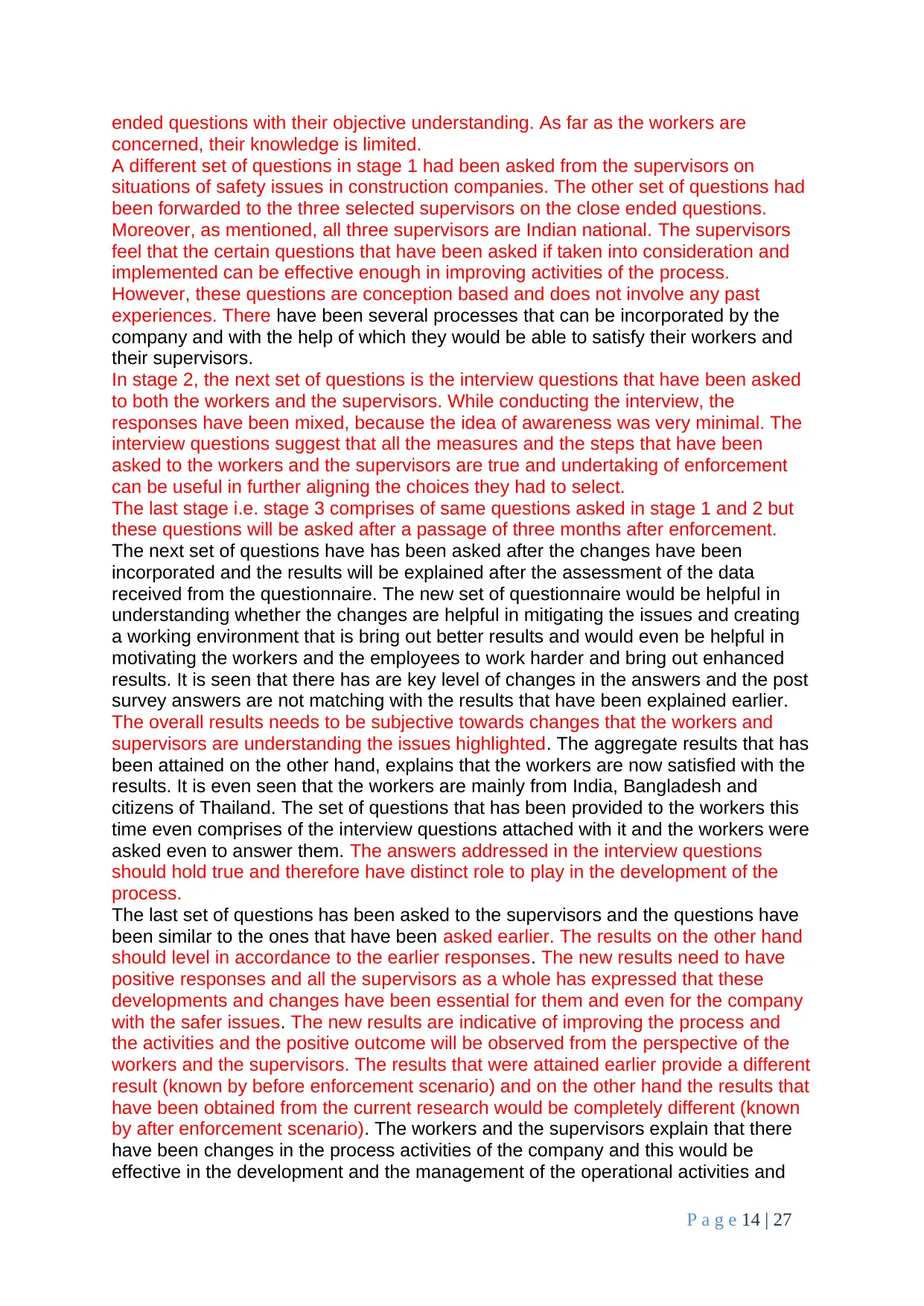
ended questions with their objective understanding. As far as the workers are
concerned, their knowledge is limited.
A different set of questions in stage 1 had been asked from the supervisors on
situations of safety issues in construction companies. The other set of questions had
been forwarded to the three selected supervisors on the close ended questions.
Moreover, as mentioned, all three supervisors are Indian national. The supervisors
feel that the certain questions that have been asked if taken into consideration and
implemented can be effective enough in improving activities of the process.
However, these questions are conception based and does not involve any past
experiences. There have been several processes that can be incorporated by the
company and with the help of which they would be able to satisfy their workers and
their supervisors.
In stage 2, the next set of questions is the interview questions that have been asked
to both the workers and the supervisors. While conducting the interview, the
responses have been mixed, because the idea of awareness was very minimal. The
interview questions suggest that all the measures and the steps that have been
asked to the workers and the supervisors are true and undertaking of enforcement
can be useful in further aligning the choices they had to select.
The last stage i.e. stage 3 comprises of same questions asked in stage 1 and 2 but
these questions will be asked after a passage of three months after enforcement.
The next set of questions have has been asked after the changes have been
incorporated and the results will be explained after the assessment of the data
received from the questionnaire. The new set of questionnaire would be helpful in
understanding whether the changes are helpful in mitigating the issues and creating
a working environment that is bring out better results and would even be helpful in
motivating the workers and the employees to work harder and bring out enhanced
results. It is seen that there has are key level of changes in the answers and the post
survey answers are not matching with the results that have been explained earlier.
The overall results needs to be subjective towards changes that the workers and
supervisors are understanding the issues highlighted. The aggregate results that has
been attained on the other hand, explains that the workers are now satisfied with the
results. It is even seen that the workers are mainly from India, Bangladesh and
citizens of Thailand. The set of questions that has been provided to the workers this
time even comprises of the interview questions attached with it and the workers were
asked even to answer them. The answers addressed in the interview questions
should hold true and therefore have distinct role to play in the development of the
process.
The last set of questions has been asked to the supervisors and the questions have
been similar to the ones that have been asked earlier. The results on the other hand
should level in accordance to the earlier responses. The new results need to have
positive responses and all the supervisors as a whole has expressed that these
developments and changes have been essential for them and even for the company
with the safer issues. The new results are indicative of improving the process and
the activities and the positive outcome will be observed from the perspective of the
workers and the supervisors. The results that were attained earlier provide a different
result (known by before enforcement scenario) and on the other hand the results that
have been obtained from the current research would be completely different (known
by after enforcement scenario). The workers and the supervisors explain that there
have been changes in the process activities of the company and this would be
effective in the development and the management of the operational activities and
P a g e 14 | 27
concerned, their knowledge is limited.
A different set of questions in stage 1 had been asked from the supervisors on
situations of safety issues in construction companies. The other set of questions had
been forwarded to the three selected supervisors on the close ended questions.
Moreover, as mentioned, all three supervisors are Indian national. The supervisors
feel that the certain questions that have been asked if taken into consideration and
implemented can be effective enough in improving activities of the process.
However, these questions are conception based and does not involve any past
experiences. There have been several processes that can be incorporated by the
company and with the help of which they would be able to satisfy their workers and
their supervisors.
In stage 2, the next set of questions is the interview questions that have been asked
to both the workers and the supervisors. While conducting the interview, the
responses have been mixed, because the idea of awareness was very minimal. The
interview questions suggest that all the measures and the steps that have been
asked to the workers and the supervisors are true and undertaking of enforcement
can be useful in further aligning the choices they had to select.
The last stage i.e. stage 3 comprises of same questions asked in stage 1 and 2 but
these questions will be asked after a passage of three months after enforcement.
The next set of questions have has been asked after the changes have been
incorporated and the results will be explained after the assessment of the data
received from the questionnaire. The new set of questionnaire would be helpful in
understanding whether the changes are helpful in mitigating the issues and creating
a working environment that is bring out better results and would even be helpful in
motivating the workers and the employees to work harder and bring out enhanced
results. It is seen that there has are key level of changes in the answers and the post
survey answers are not matching with the results that have been explained earlier.
The overall results needs to be subjective towards changes that the workers and
supervisors are understanding the issues highlighted. The aggregate results that has
been attained on the other hand, explains that the workers are now satisfied with the
results. It is even seen that the workers are mainly from India, Bangladesh and
citizens of Thailand. The set of questions that has been provided to the workers this
time even comprises of the interview questions attached with it and the workers were
asked even to answer them. The answers addressed in the interview questions
should hold true and therefore have distinct role to play in the development of the
process.
The last set of questions has been asked to the supervisors and the questions have
been similar to the ones that have been asked earlier. The results on the other hand
should level in accordance to the earlier responses. The new results need to have
positive responses and all the supervisors as a whole has expressed that these
developments and changes have been essential for them and even for the company
with the safer issues. The new results are indicative of improving the process and
the activities and the positive outcome will be observed from the perspective of the
workers and the supervisors. The results that were attained earlier provide a different
result (known by before enforcement scenario) and on the other hand the results that
have been obtained from the current research would be completely different (known
by after enforcement scenario). The workers and the supervisors explain that there
have been changes in the process activities of the company and this would be
effective in the development and the management of the operational activities and
P a g e 14 | 27
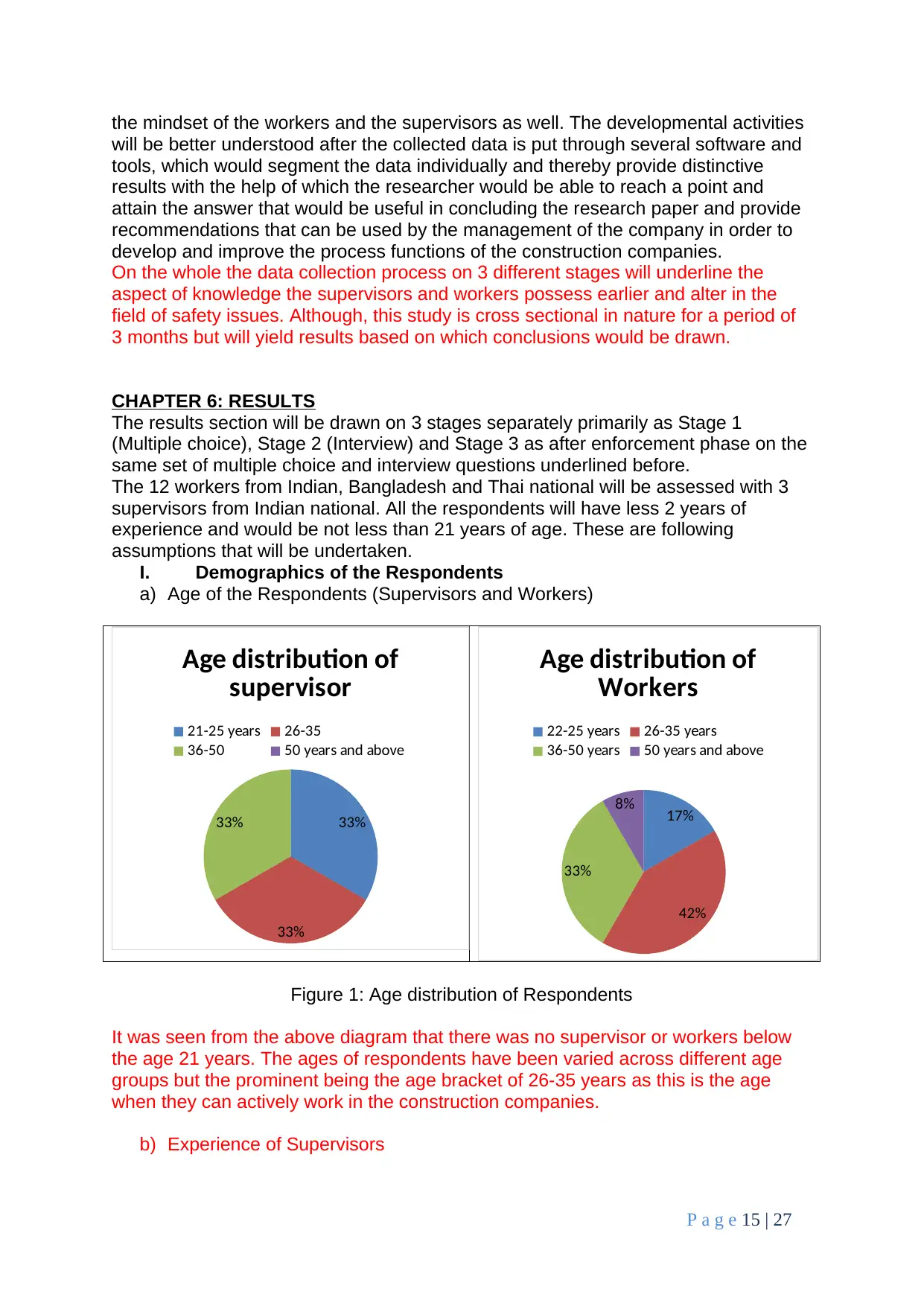
the mindset of the workers and the supervisors as well. The developmental activities
will be better understood after the collected data is put through several software and
tools, which would segment the data individually and thereby provide distinctive
results with the help of which the researcher would be able to reach a point and
attain the answer that would be useful in concluding the research paper and provide
recommendations that can be used by the management of the company in order to
develop and improve the process functions of the construction companies.
On the whole the data collection process on 3 different stages will underline the
aspect of knowledge the supervisors and workers possess earlier and alter in the
field of safety issues. Although, this study is cross sectional in nature for a period of
3 months but will yield results based on which conclusions would be drawn.
CHAPTER 6: RESULTS
The results section will be drawn on 3 stages separately primarily as Stage 1
(Multiple choice), Stage 2 (Interview) and Stage 3 as after enforcement phase on the
same set of multiple choice and interview questions underlined before.
The 12 workers from Indian, Bangladesh and Thai national will be assessed with 3
supervisors from Indian national. All the respondents will have less 2 years of
experience and would be not less than 21 years of age. These are following
assumptions that will be undertaken.
I. Demographics of the Respondents
a) Age of the Respondents (Supervisors and Workers)
33%
33%
33%
Age distribution of
supervisor
21-25 years 26-35
36-50 50 years and above
17%
42%
33%
8%
Age distribution of
Workers
22-25 years 26-35 years
36-50 years 50 years and above
Figure 1: Age distribution of Respondents
It was seen from the above diagram that there was no supervisor or workers below
the age 21 years. The ages of respondents have been varied across different age
groups but the prominent being the age bracket of 26-35 years as this is the age
when they can actively work in the construction companies.
b) Experience of Supervisors
P a g e 15 | 27
will be better understood after the collected data is put through several software and
tools, which would segment the data individually and thereby provide distinctive
results with the help of which the researcher would be able to reach a point and
attain the answer that would be useful in concluding the research paper and provide
recommendations that can be used by the management of the company in order to
develop and improve the process functions of the construction companies.
On the whole the data collection process on 3 different stages will underline the
aspect of knowledge the supervisors and workers possess earlier and alter in the
field of safety issues. Although, this study is cross sectional in nature for a period of
3 months but will yield results based on which conclusions would be drawn.
CHAPTER 6: RESULTS
The results section will be drawn on 3 stages separately primarily as Stage 1
(Multiple choice), Stage 2 (Interview) and Stage 3 as after enforcement phase on the
same set of multiple choice and interview questions underlined before.
The 12 workers from Indian, Bangladesh and Thai national will be assessed with 3
supervisors from Indian national. All the respondents will have less 2 years of
experience and would be not less than 21 years of age. These are following
assumptions that will be undertaken.
I. Demographics of the Respondents
a) Age of the Respondents (Supervisors and Workers)
33%
33%
33%
Age distribution of
supervisor
21-25 years 26-35
36-50 50 years and above
17%
42%
33%
8%
Age distribution of
Workers
22-25 years 26-35 years
36-50 years 50 years and above
Figure 1: Age distribution of Respondents
It was seen from the above diagram that there was no supervisor or workers below
the age 21 years. The ages of respondents have been varied across different age
groups but the prominent being the age bracket of 26-35 years as this is the age
when they can actively work in the construction companies.
b) Experience of Supervisors
P a g e 15 | 27
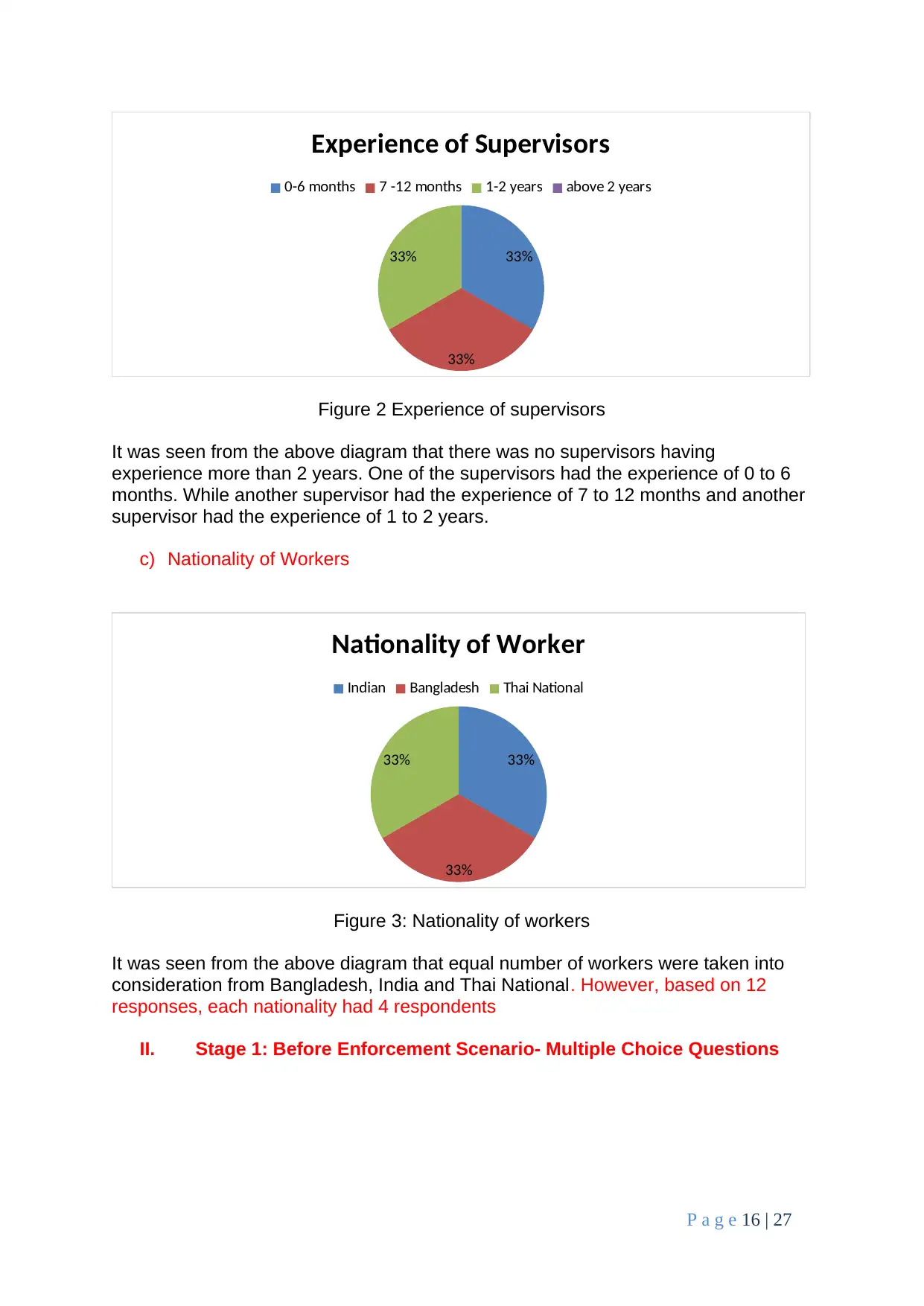
33%
33%
33%
Experience of Supervisors
0-6 months 7 -12 months 1-2 years above 2 years
Figure 2 Experience of supervisors
It was seen from the above diagram that there was no supervisors having
experience more than 2 years. One of the supervisors had the experience of 0 to 6
months. While another supervisor had the experience of 7 to 12 months and another
supervisor had the experience of 1 to 2 years.
c) Nationality of Workers
33%
33%
33%
Nationality of Worker
Indian Bangladesh Thai National
Figure 3: Nationality of workers
It was seen from the above diagram that equal number of workers were taken into
consideration from Bangladesh, India and Thai National. However, based on 12
responses, each nationality had 4 respondents
II. Stage 1: Before Enforcement Scenario- Multiple Choice Questions
P a g e 16 | 27
33%
33%
Experience of Supervisors
0-6 months 7 -12 months 1-2 years above 2 years
Figure 2 Experience of supervisors
It was seen from the above diagram that there was no supervisors having
experience more than 2 years. One of the supervisors had the experience of 0 to 6
months. While another supervisor had the experience of 7 to 12 months and another
supervisor had the experience of 1 to 2 years.
c) Nationality of Workers
33%
33%
33%
Nationality of Worker
Indian Bangladesh Thai National
Figure 3: Nationality of workers
It was seen from the above diagram that equal number of workers were taken into
consideration from Bangladesh, India and Thai National. However, based on 12
responses, each nationality had 4 respondents
II. Stage 1: Before Enforcement Scenario- Multiple Choice Questions
P a g e 16 | 27
Secure Best Marks with AI Grader
Need help grading? Try our AI Grader for instant feedback on your assignments.
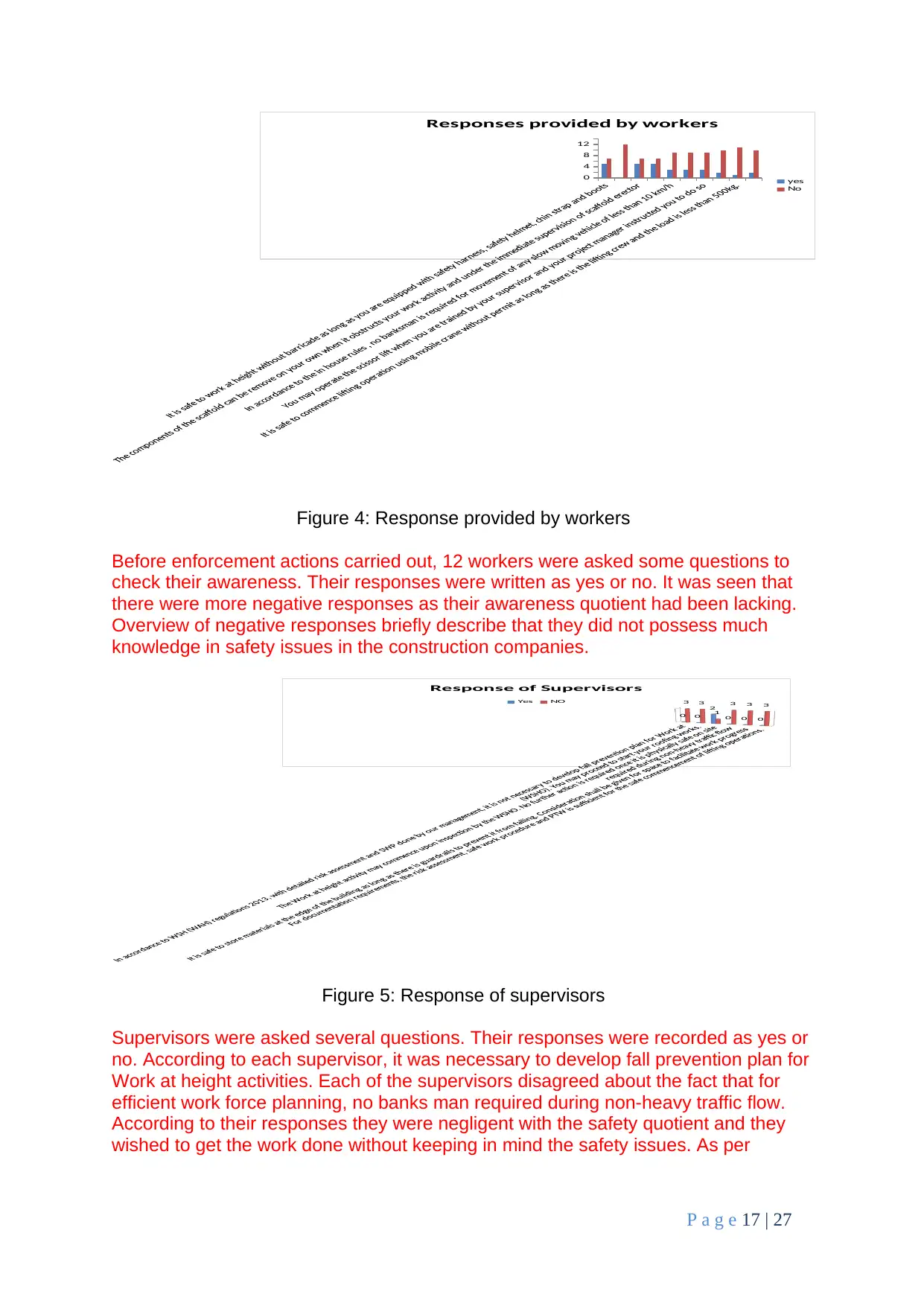
0
4
8
12
Responses provided by workers
yes
No
Figure 4: Response provided by workers
Before enforcement actions carried out, 12 workers were asked some questions to
check their awareness. Their responses were written as yes or no. It was seen that
there were more negative responses as their awareness quotient had been lacking.
Overview of negative responses briefly describe that they did not possess much
knowledge in safety issues in the construction companies.
0 0
2
0 0 0
3 3
1
3 3 3
Response of Supervisors
Yes NO
Figure 5: Response of supervisors
Supervisors were asked several questions. Their responses were recorded as yes or
no. According to each supervisor, it was necessary to develop fall prevention plan for
Work at height activities. Each of the supervisors disagreed about the fact that for
efficient work force planning, no banks man required during non-heavy traffic flow.
According to their responses they were negligent with the safety quotient and they
wished to get the work done without keeping in mind the safety issues. As per
P a g e 17 | 27
4
8
12
Responses provided by workers
yes
No
Figure 4: Response provided by workers
Before enforcement actions carried out, 12 workers were asked some questions to
check their awareness. Their responses were written as yes or no. It was seen that
there were more negative responses as their awareness quotient had been lacking.
Overview of negative responses briefly describe that they did not possess much
knowledge in safety issues in the construction companies.
0 0
2
0 0 0
3 3
1
3 3 3
Response of Supervisors
Yes NO
Figure 5: Response of supervisors
Supervisors were asked several questions. Their responses were recorded as yes or
no. According to each supervisor, it was necessary to develop fall prevention plan for
Work at height activities. Each of the supervisors disagreed about the fact that for
efficient work force planning, no banks man required during non-heavy traffic flow.
According to their responses they were negligent with the safety quotient and they
wished to get the work done without keeping in mind the safety issues. As per
P a g e 17 | 27
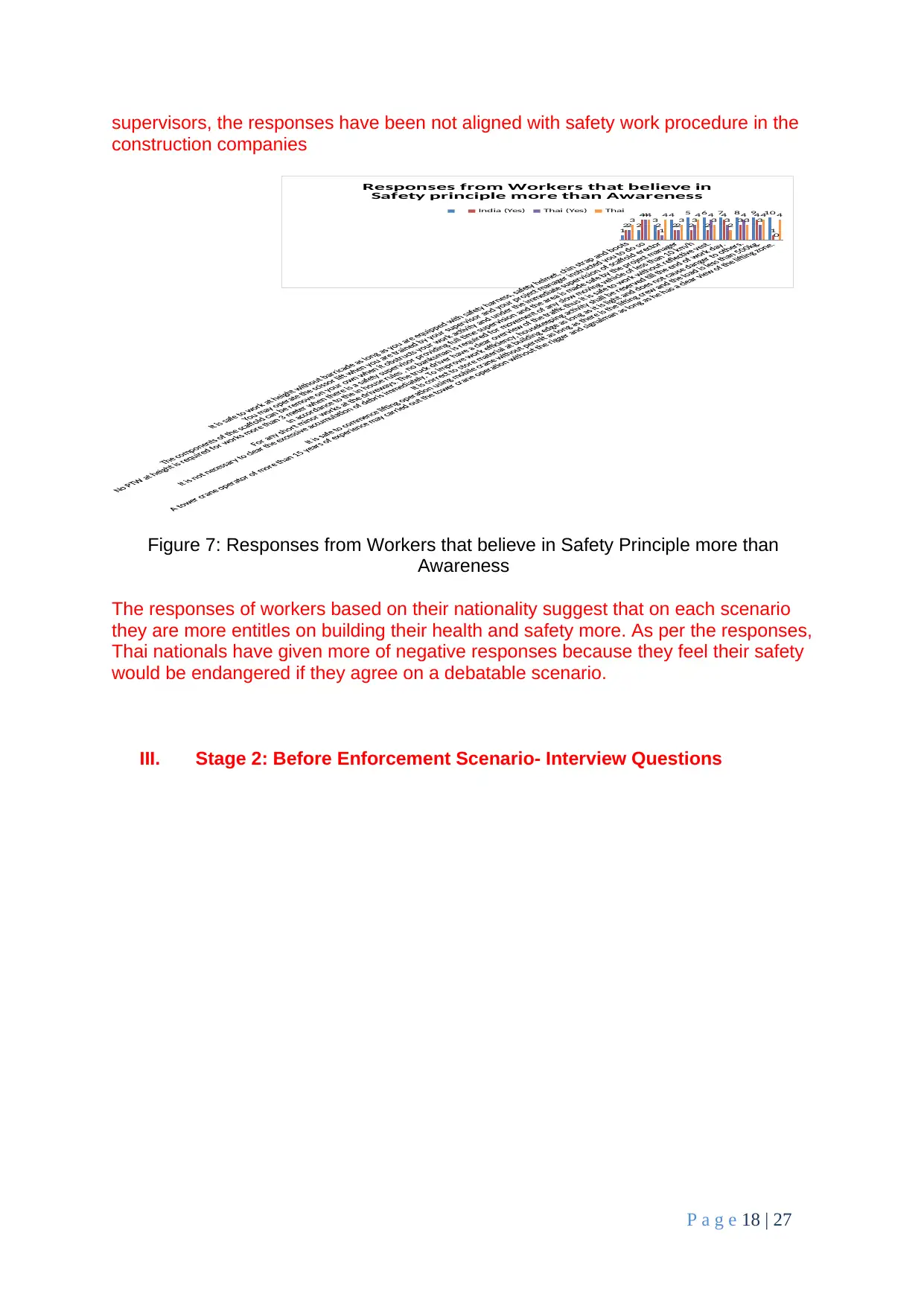
supervisors, the responses have been not aligned with safety work procedure in the
construction companies
1 2
3 4 5 6 7 8 9 10
2
4
2 2 2 2
4 3 4
1
2
4
1 2
3 4 3 4 3
0
3 4 4 3 4 3
2
3 4 4
Responses from Workers that believe in
Safety principle more than Awareness
India (Yes) Thai (Yes) Thai
Figure 7: Responses from Workers that believe in Safety Principle more than
Awareness
The responses of workers based on their nationality suggest that on each scenario
they are more entitles on building their health and safety more. As per the responses,
Thai nationals have given more of negative responses because they feel their safety
would be endangered if they agree on a debatable scenario.
III. Stage 2: Before Enforcement Scenario- Interview Questions
P a g e 18 | 27
construction companies
1 2
3 4 5 6 7 8 9 10
2
4
2 2 2 2
4 3 4
1
2
4
1 2
3 4 3 4 3
0
3 4 4 3 4 3
2
3 4 4
Responses from Workers that believe in
Safety principle more than Awareness
India (Yes) Thai (Yes) Thai
Figure 7: Responses from Workers that believe in Safety Principle more than
Awareness
The responses of workers based on their nationality suggest that on each scenario
they are more entitles on building their health and safety more. As per the responses,
Thai nationals have given more of negative responses because they feel their safety
would be endangered if they agree on a debatable scenario.
III. Stage 2: Before Enforcement Scenario- Interview Questions
P a g e 18 | 27
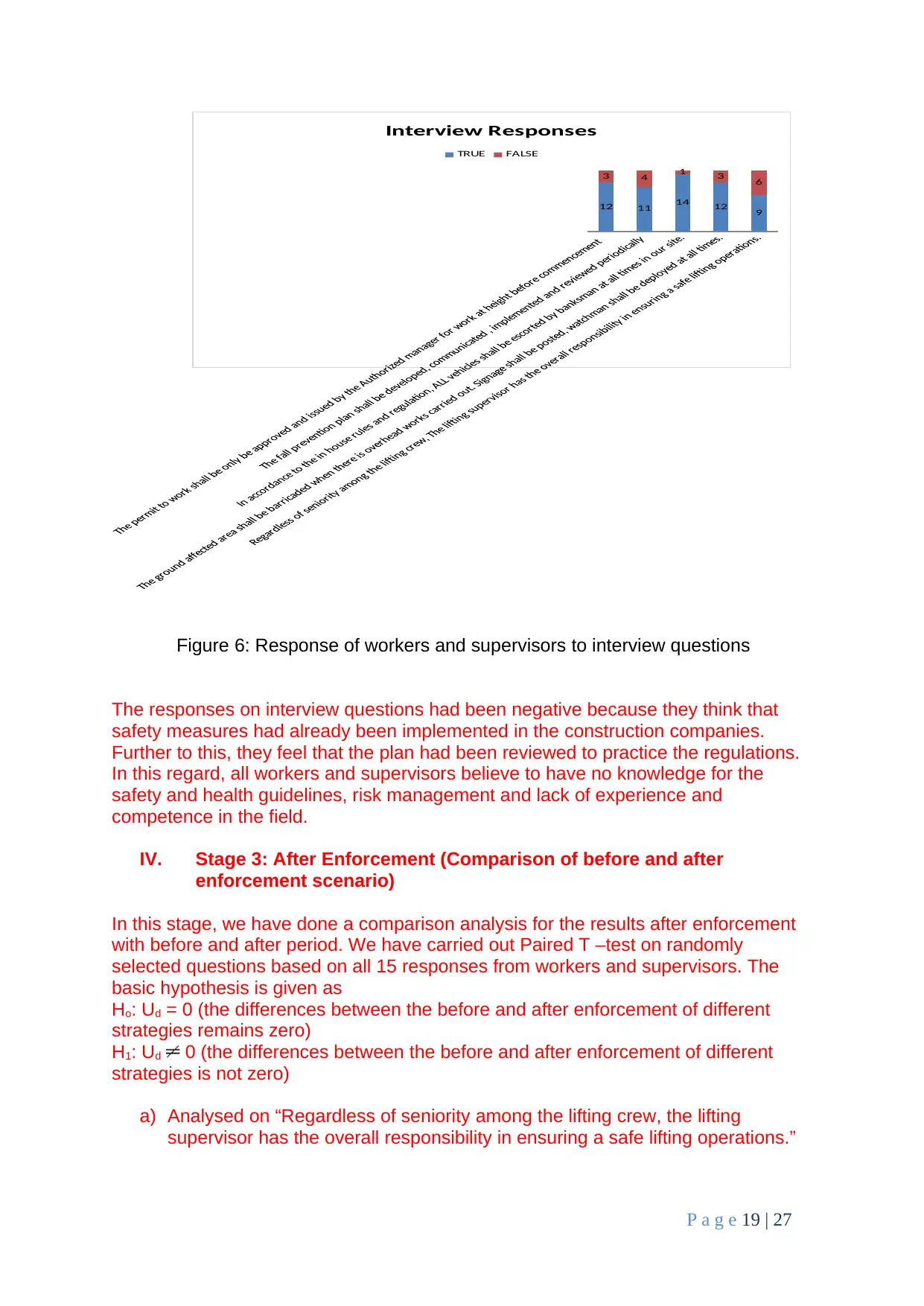
12 11 14 12 9
3 4 1 3 6
Interview Responses
TRUE FALSE
Figure 6: Response of workers and supervisors to interview questions
The responses on interview questions had been negative because they think that
safety measures had already been implemented in the construction companies.
Further to this, they feel that the plan had been reviewed to practice the regulations.
In this regard, all workers and supervisors believe to have no knowledge for the
safety and health guidelines, risk management and lack of experience and
competence in the field.
IV. Stage 3: After Enforcement (Comparison of before and after
enforcement scenario)
In this stage, we have done a comparison analysis for the results after enforcement
with before and after period. We have carried out Paired T –test on randomly
selected questions based on all 15 responses from workers and supervisors. The
basic hypothesis is given as
Ho: Ud = 0 (the differences between the before and after enforcement of different
strategies remains zero)
H1: Ud 0 (the differences between the before and after enforcement of different
strategies is not zero)
a) Analysed on “Regardless of seniority among the lifting crew, the lifting
supervisor has the overall responsibility in ensuring a safe lifting operations.”
P a g e 19 | 27
3 4 1 3 6
Interview Responses
TRUE FALSE
Figure 6: Response of workers and supervisors to interview questions
The responses on interview questions had been negative because they think that
safety measures had already been implemented in the construction companies.
Further to this, they feel that the plan had been reviewed to practice the regulations.
In this regard, all workers and supervisors believe to have no knowledge for the
safety and health guidelines, risk management and lack of experience and
competence in the field.
IV. Stage 3: After Enforcement (Comparison of before and after
enforcement scenario)
In this stage, we have done a comparison analysis for the results after enforcement
with before and after period. We have carried out Paired T –test on randomly
selected questions based on all 15 responses from workers and supervisors. The
basic hypothesis is given as
Ho: Ud = 0 (the differences between the before and after enforcement of different
strategies remains zero)
H1: Ud 0 (the differences between the before and after enforcement of different
strategies is not zero)
a) Analysed on “Regardless of seniority among the lifting crew, the lifting
supervisor has the overall responsibility in ensuring a safe lifting operations.”
P a g e 19 | 27
Paraphrase This Document
Need a fresh take? Get an instant paraphrase of this document with our AI Paraphraser
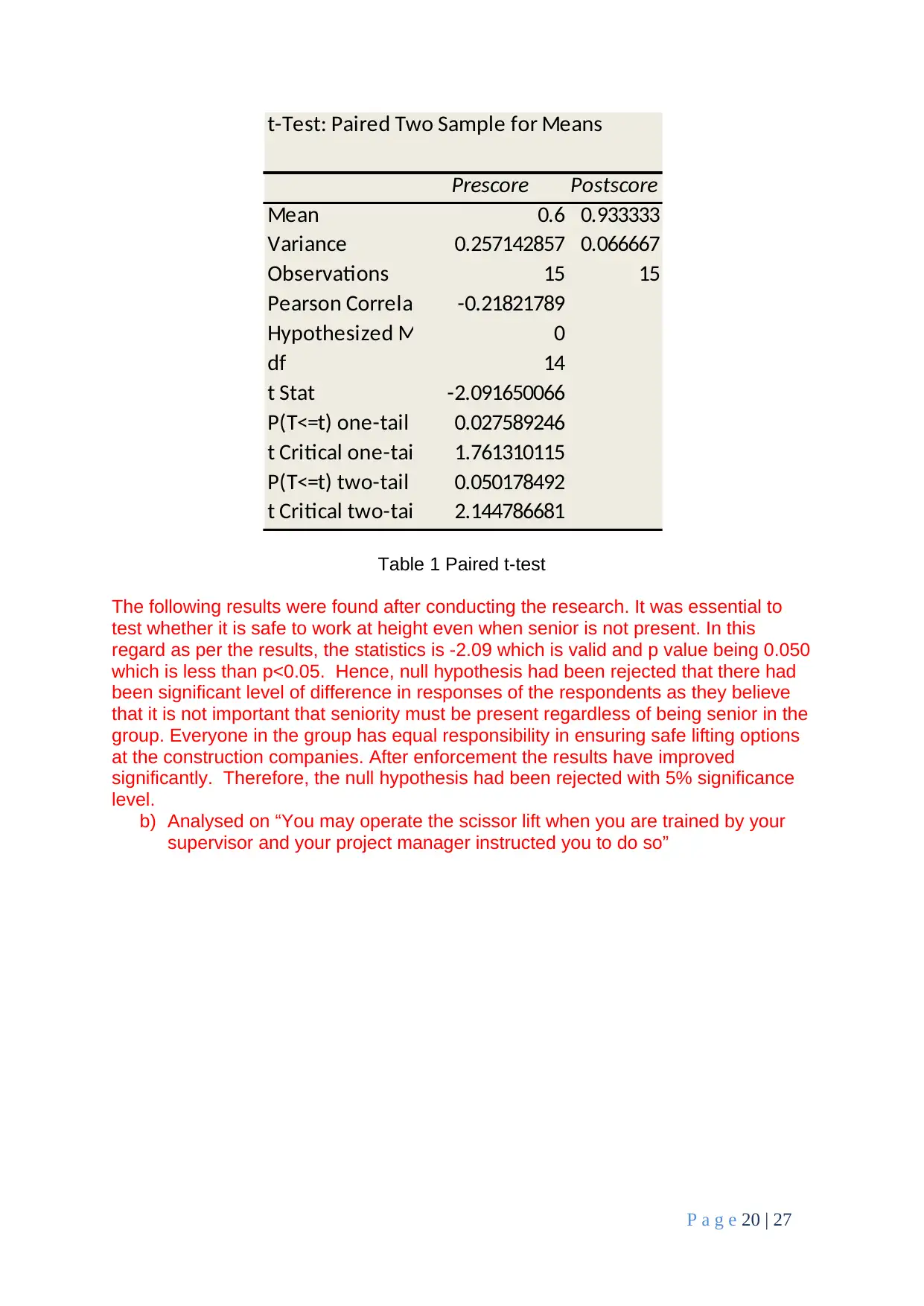
t-Test: Paired Two Sample for Means
Prescore Postscore
Mean 0.6 0.933333
Variance 0.257142857 0.066667
Observations 15 15
Pearson Correlation -0.21821789
Hypothesized Mean Difference 0
df 14
t Stat -2.091650066
P(T<=t) one-tail 0.027589246
t Critical one-tail 1.761310115
P(T<=t) two-tail 0.050178492
t Critical two-tail 2.144786681
Table 1 Paired t-test
The following results were found after conducting the research. It was essential to
test whether it is safe to work at height even when senior is not present. In this
regard as per the results, the statistics is -2.09 which is valid and p value being 0.050
which is less than p<0.05. Hence, null hypothesis had been rejected that there had
been significant level of difference in responses of the respondents as they believe
that it is not important that seniority must be present regardless of being senior in the
group. Everyone in the group has equal responsibility in ensuring safe lifting options
at the construction companies. After enforcement the results have improved
significantly. Therefore, the null hypothesis had been rejected with 5% significance
level.
b) Analysed on “You may operate the scissor lift when you are trained by your
supervisor and your project manager instructed you to do so”
P a g e 20 | 27
Prescore Postscore
Mean 0.6 0.933333
Variance 0.257142857 0.066667
Observations 15 15
Pearson Correlation -0.21821789
Hypothesized Mean Difference 0
df 14
t Stat -2.091650066
P(T<=t) one-tail 0.027589246
t Critical one-tail 1.761310115
P(T<=t) two-tail 0.050178492
t Critical two-tail 2.144786681
Table 1 Paired t-test
The following results were found after conducting the research. It was essential to
test whether it is safe to work at height even when senior is not present. In this
regard as per the results, the statistics is -2.09 which is valid and p value being 0.050
which is less than p<0.05. Hence, null hypothesis had been rejected that there had
been significant level of difference in responses of the respondents as they believe
that it is not important that seniority must be present regardless of being senior in the
group. Everyone in the group has equal responsibility in ensuring safe lifting options
at the construction companies. After enforcement the results have improved
significantly. Therefore, the null hypothesis had been rejected with 5% significance
level.
b) Analysed on “You may operate the scissor lift when you are trained by your
supervisor and your project manager instructed you to do so”
P a g e 20 | 27

t-Test: Paired Two Sample for Means
Prescore Postscore
Mean 0 0.666666667
Variance 0 0.242424242
Observations 12 12
Pearson CorrelationNA
Hypothesized Mean Difference0
df 11
t Stat -4.69041576
P(T<=t) one-tail 0.000330157
t Critical one-tail 1.795884814
P(T<=t) two-tail 0.000660314
t Critical two-tail 2.200985159
Table 2 Paired t-test
The following results were found after conducting the research. It was essential to
test whether it is safe to use scissor lift when you are trained or instructed to do so .
In this regard as per the results, the statistics is -4.69 which is valid and p value
being 0.0006 which is less than p<0.05. Hence, null hypothesis had been rejected
that there had been significant level of difference in responses of the respondents as
they believe when trained you should know the use of scissor lift only when one is
confident to take it forward even if instructed. In construction companies, scissors lift
hold to be used only with proper instructions and prior knowledge with experience.
After enforcement the results have improved significantly. Therefore, the null
hypothesis had been rejected at 95% level of significance emphasizing that if the
tests are repeated with same number of employees, 95% results would be statically
significant.
c) Analysed on “No PTW at height is required for works more than 3 meter when
there is a safety supervisor providing full time supervision and the area is
made safe by the project manager”
P a g e 21 | 27
Prescore Postscore
Mean 0 0.666666667
Variance 0 0.242424242
Observations 12 12
Pearson CorrelationNA
Hypothesized Mean Difference0
df 11
t Stat -4.69041576
P(T<=t) one-tail 0.000330157
t Critical one-tail 1.795884814
P(T<=t) two-tail 0.000660314
t Critical two-tail 2.200985159
Table 2 Paired t-test
The following results were found after conducting the research. It was essential to
test whether it is safe to use scissor lift when you are trained or instructed to do so .
In this regard as per the results, the statistics is -4.69 which is valid and p value
being 0.0006 which is less than p<0.05. Hence, null hypothesis had been rejected
that there had been significant level of difference in responses of the respondents as
they believe when trained you should know the use of scissor lift only when one is
confident to take it forward even if instructed. In construction companies, scissors lift
hold to be used only with proper instructions and prior knowledge with experience.
After enforcement the results have improved significantly. Therefore, the null
hypothesis had been rejected at 95% level of significance emphasizing that if the
tests are repeated with same number of employees, 95% results would be statically
significant.
c) Analysed on “No PTW at height is required for works more than 3 meter when
there is a safety supervisor providing full time supervision and the area is
made safe by the project manager”
P a g e 21 | 27
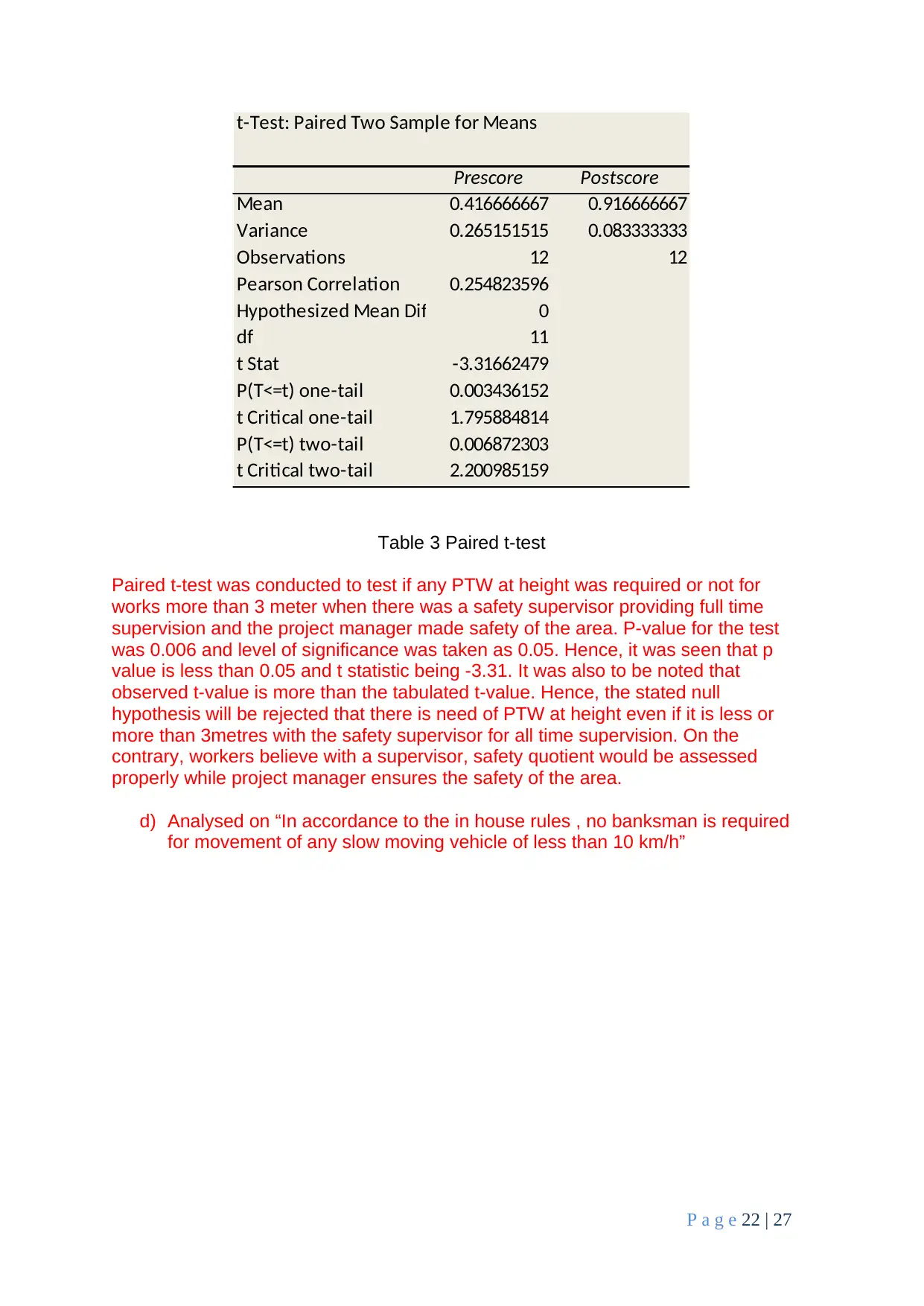
t-Test: Paired Two Sample for Means
Prescore Postscore
Mean 0.416666667 0.916666667
Variance 0.265151515 0.083333333
Observations 12 12
Pearson Correlation 0.254823596
Hypothesized Mean Difference 0
df 11
t Stat -3.31662479
P(T<=t) one-tail 0.003436152
t Critical one-tail 1.795884814
P(T<=t) two-tail 0.006872303
t Critical two-tail 2.200985159
Table 3 Paired t-test
Paired t-test was conducted to test if any PTW at height was required or not for
works more than 3 meter when there was a safety supervisor providing full time
supervision and the project manager made safety of the area. P-value for the test
was 0.006 and level of significance was taken as 0.05. Hence, it was seen that p
value is less than 0.05 and t statistic being -3.31. It was also to be noted that
observed t-value is more than the tabulated t-value. Hence, the stated null
hypothesis will be rejected that there is need of PTW at height even if it is less or
more than 3metres with the safety supervisor for all time supervision. On the
contrary, workers believe with a supervisor, safety quotient would be assessed
properly while project manager ensures the safety of the area.
d) Analysed on “In accordance to the in house rules , no banksman is required
for movement of any slow moving vehicle of less than 10 km/h”
P a g e 22 | 27
Prescore Postscore
Mean 0.416666667 0.916666667
Variance 0.265151515 0.083333333
Observations 12 12
Pearson Correlation 0.254823596
Hypothesized Mean Difference 0
df 11
t Stat -3.31662479
P(T<=t) one-tail 0.003436152
t Critical one-tail 1.795884814
P(T<=t) two-tail 0.006872303
t Critical two-tail 2.200985159
Table 3 Paired t-test
Paired t-test was conducted to test if any PTW at height was required or not for
works more than 3 meter when there was a safety supervisor providing full time
supervision and the project manager made safety of the area. P-value for the test
was 0.006 and level of significance was taken as 0.05. Hence, it was seen that p
value is less than 0.05 and t statistic being -3.31. It was also to be noted that
observed t-value is more than the tabulated t-value. Hence, the stated null
hypothesis will be rejected that there is need of PTW at height even if it is less or
more than 3metres with the safety supervisor for all time supervision. On the
contrary, workers believe with a supervisor, safety quotient would be assessed
properly while project manager ensures the safety of the area.
d) Analysed on “In accordance to the in house rules , no banksman is required
for movement of any slow moving vehicle of less than 10 km/h”
P a g e 22 | 27
Secure Best Marks with AI Grader
Need help grading? Try our AI Grader for instant feedback on your assignments.
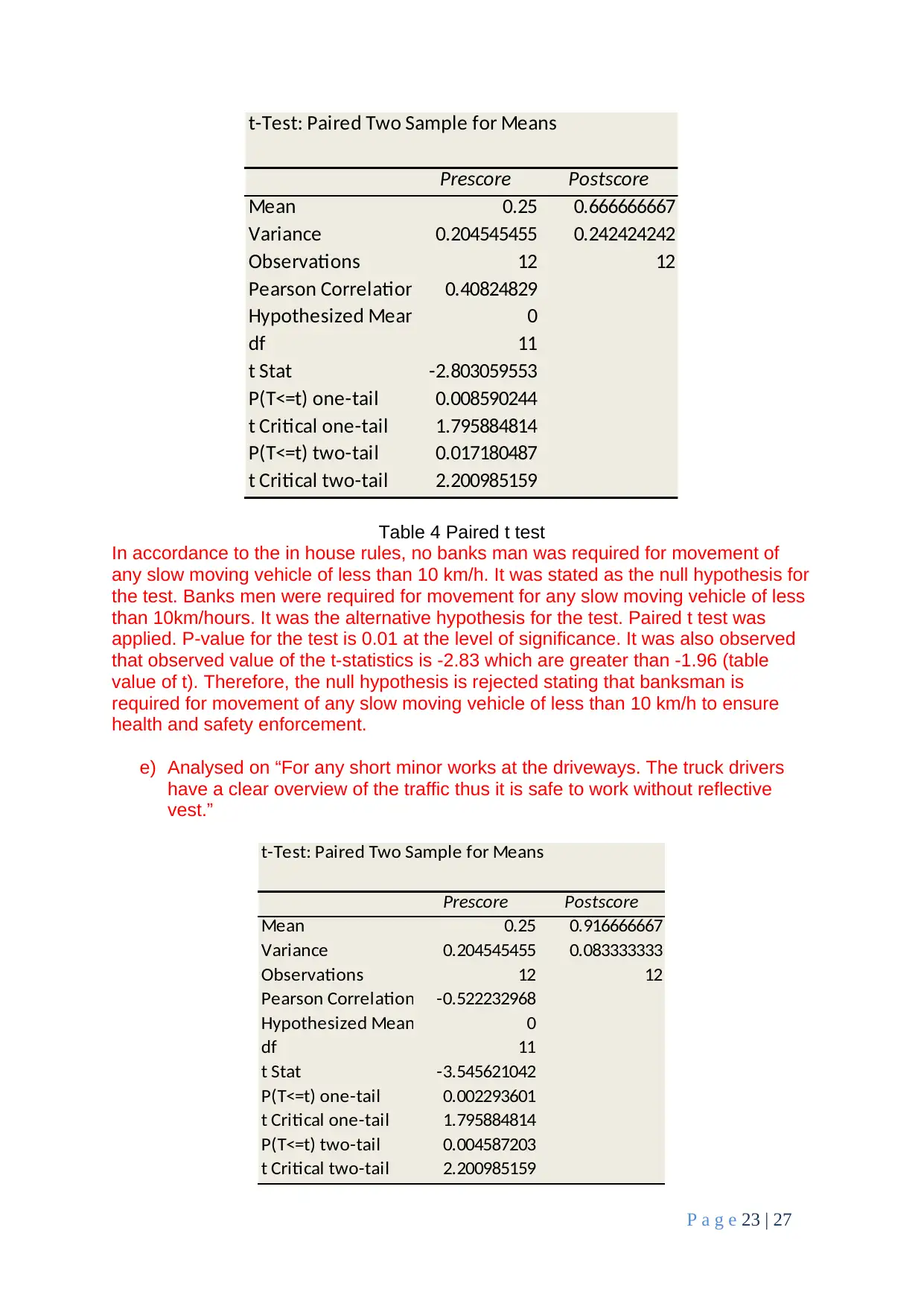
t-Test: Paired Two Sample for Means
Prescore Postscore
Mean 0.25 0.666666667
Variance 0.204545455 0.242424242
Observations 12 12
Pearson Correlation 0.40824829
Hypothesized Mean Difference 0
df 11
t Stat -2.803059553
P(T<=t) one-tail 0.008590244
t Critical one-tail 1.795884814
P(T<=t) two-tail 0.017180487
t Critical two-tail 2.200985159
Table 4 Paired t test
In accordance to the in house rules, no banks man was required for movement of
any slow moving vehicle of less than 10 km/h. It was stated as the null hypothesis for
the test. Banks men were required for movement for any slow moving vehicle of less
than 10km/hours. It was the alternative hypothesis for the test. Paired t test was
applied. P-value for the test is 0.01 at the level of significance. It was also observed
that observed value of the t-statistics is -2.83 which are greater than -1.96 (table
value of t). Therefore, the null hypothesis is rejected stating that banksman is
required for movement of any slow moving vehicle of less than 10 km/h to ensure
health and safety enforcement.
e) Analysed on “For any short minor works at the driveways. The truck drivers
have a clear overview of the traffic thus it is safe to work without reflective
vest.”
t-Test: Paired Two Sample for Means
Prescore Postscore
Mean 0.25 0.916666667
Variance 0.204545455 0.083333333
Observations 12 12
Pearson Correlation -0.522232968
Hypothesized Mean Difference 0
df 11
t Stat -3.545621042
P(T<=t) one-tail 0.002293601
t Critical one-tail 1.795884814
P(T<=t) two-tail 0.004587203
t Critical two-tail 2.200985159
P a g e 23 | 27
Prescore Postscore
Mean 0.25 0.666666667
Variance 0.204545455 0.242424242
Observations 12 12
Pearson Correlation 0.40824829
Hypothesized Mean Difference 0
df 11
t Stat -2.803059553
P(T<=t) one-tail 0.008590244
t Critical one-tail 1.795884814
P(T<=t) two-tail 0.017180487
t Critical two-tail 2.200985159
Table 4 Paired t test
In accordance to the in house rules, no banks man was required for movement of
any slow moving vehicle of less than 10 km/h. It was stated as the null hypothesis for
the test. Banks men were required for movement for any slow moving vehicle of less
than 10km/hours. It was the alternative hypothesis for the test. Paired t test was
applied. P-value for the test is 0.01 at the level of significance. It was also observed
that observed value of the t-statistics is -2.83 which are greater than -1.96 (table
value of t). Therefore, the null hypothesis is rejected stating that banksman is
required for movement of any slow moving vehicle of less than 10 km/h to ensure
health and safety enforcement.
e) Analysed on “For any short minor works at the driveways. The truck drivers
have a clear overview of the traffic thus it is safe to work without reflective
vest.”
t-Test: Paired Two Sample for Means
Prescore Postscore
Mean 0.25 0.916666667
Variance 0.204545455 0.083333333
Observations 12 12
Pearson Correlation -0.522232968
Hypothesized Mean Difference 0
df 11
t Stat -3.545621042
P(T<=t) one-tail 0.002293601
t Critical one-tail 1.795884814
P(T<=t) two-tail 0.004587203
t Critical two-tail 2.200985159
P a g e 23 | 27
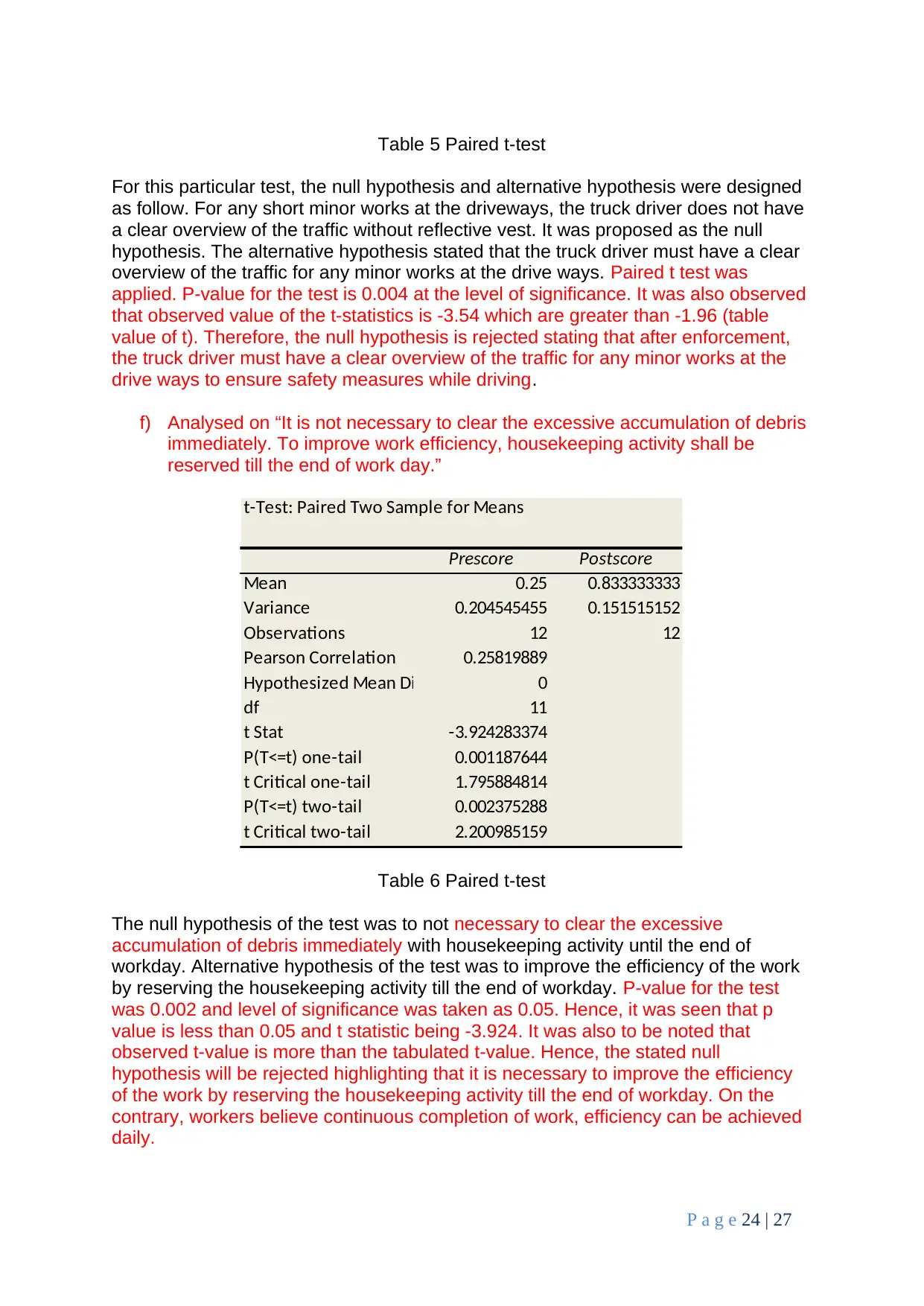
Table 5 Paired t-test
For this particular test, the null hypothesis and alternative hypothesis were designed
as follow. For any short minor works at the driveways, the truck driver does not have
a clear overview of the traffic without reflective vest. It was proposed as the null
hypothesis. The alternative hypothesis stated that the truck driver must have a clear
overview of the traffic for any minor works at the drive ways. Paired t test was
applied. P-value for the test is 0.004 at the level of significance. It was also observed
that observed value of the t-statistics is -3.54 which are greater than -1.96 (table
value of t). Therefore, the null hypothesis is rejected stating that after enforcement,
the truck driver must have a clear overview of the traffic for any minor works at the
drive ways to ensure safety measures while driving.
f) Analysed on “It is not necessary to clear the excessive accumulation of debris
immediately. To improve work efficiency, housekeeping activity shall be
reserved till the end of work day.”
t-Test: Paired Two Sample for Means
Prescore Postscore
Mean 0.25 0.833333333
Variance 0.204545455 0.151515152
Observations 12 12
Pearson Correlation 0.25819889
Hypothesized Mean Difference 0
df 11
t Stat -3.924283374
P(T<=t) one-tail 0.001187644
t Critical one-tail 1.795884814
P(T<=t) two-tail 0.002375288
t Critical two-tail 2.200985159
Table 6 Paired t-test
The null hypothesis of the test was to not necessary to clear the excessive
accumulation of debris immediately with housekeeping activity until the end of
workday. Alternative hypothesis of the test was to improve the efficiency of the work
by reserving the housekeeping activity till the end of workday. P-value for the test
was 0.002 and level of significance was taken as 0.05. Hence, it was seen that p
value is less than 0.05 and t statistic being -3.924. It was also to be noted that
observed t-value is more than the tabulated t-value. Hence, the stated null
hypothesis will be rejected highlighting that it is necessary to improve the efficiency
of the work by reserving the housekeeping activity till the end of workday. On the
contrary, workers believe continuous completion of work, efficiency can be achieved
daily.
P a g e 24 | 27
For this particular test, the null hypothesis and alternative hypothesis were designed
as follow. For any short minor works at the driveways, the truck driver does not have
a clear overview of the traffic without reflective vest. It was proposed as the null
hypothesis. The alternative hypothesis stated that the truck driver must have a clear
overview of the traffic for any minor works at the drive ways. Paired t test was
applied. P-value for the test is 0.004 at the level of significance. It was also observed
that observed value of the t-statistics is -3.54 which are greater than -1.96 (table
value of t). Therefore, the null hypothesis is rejected stating that after enforcement,
the truck driver must have a clear overview of the traffic for any minor works at the
drive ways to ensure safety measures while driving.
f) Analysed on “It is not necessary to clear the excessive accumulation of debris
immediately. To improve work efficiency, housekeeping activity shall be
reserved till the end of work day.”
t-Test: Paired Two Sample for Means
Prescore Postscore
Mean 0.25 0.833333333
Variance 0.204545455 0.151515152
Observations 12 12
Pearson Correlation 0.25819889
Hypothesized Mean Difference 0
df 11
t Stat -3.924283374
P(T<=t) one-tail 0.001187644
t Critical one-tail 1.795884814
P(T<=t) two-tail 0.002375288
t Critical two-tail 2.200985159
Table 6 Paired t-test
The null hypothesis of the test was to not necessary to clear the excessive
accumulation of debris immediately with housekeeping activity until the end of
workday. Alternative hypothesis of the test was to improve the efficiency of the work
by reserving the housekeeping activity till the end of workday. P-value for the test
was 0.002 and level of significance was taken as 0.05. Hence, it was seen that p
value is less than 0.05 and t statistic being -3.924. It was also to be noted that
observed t-value is more than the tabulated t-value. Hence, the stated null
hypothesis will be rejected highlighting that it is necessary to improve the efficiency
of the work by reserving the housekeeping activity till the end of workday. On the
contrary, workers believe continuous completion of work, efficiency can be achieved
daily.
P a g e 24 | 27
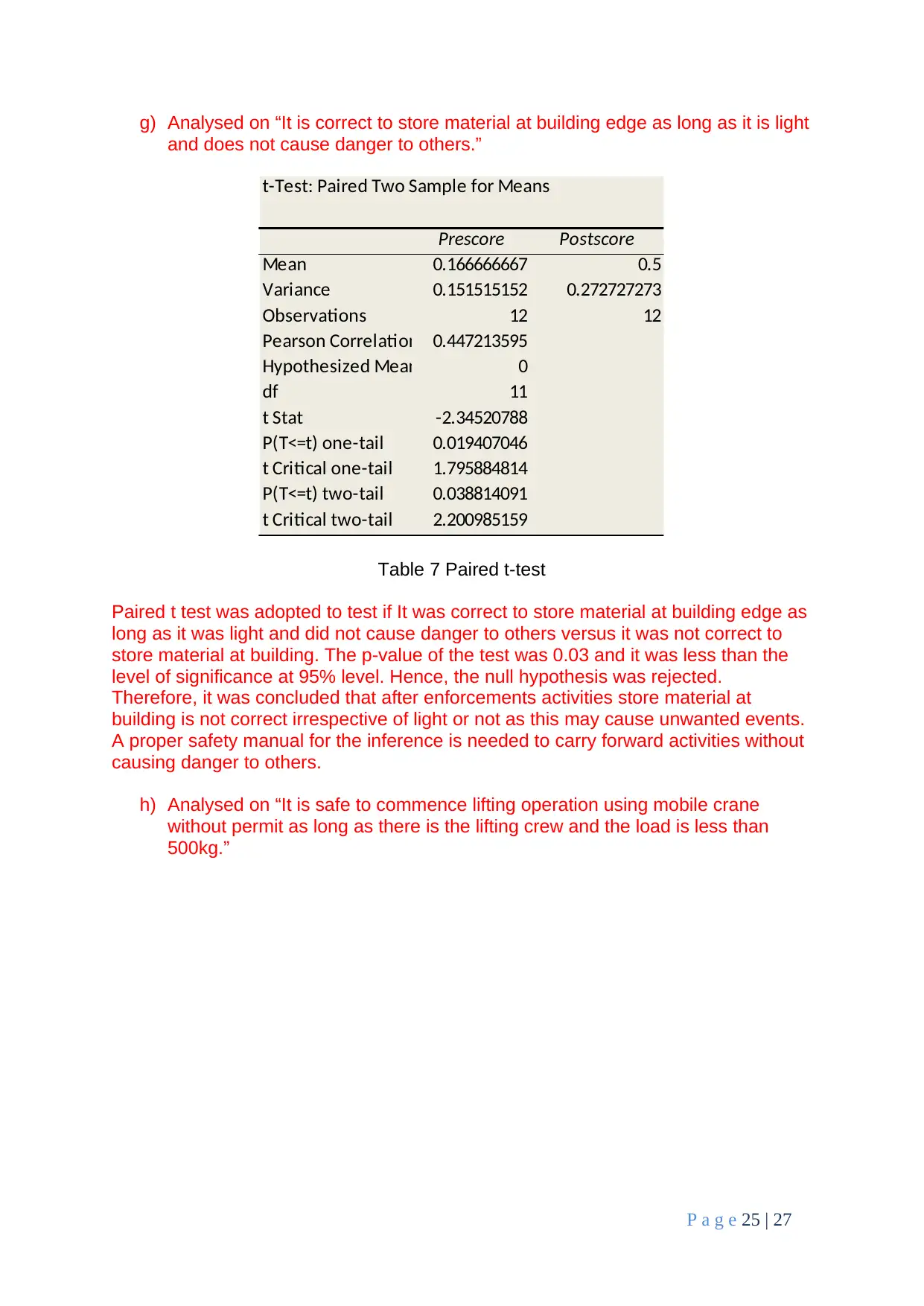
g) Analysed on “It is correct to store material at building edge as long as it is light
and does not cause danger to others.”
t-Test: Paired Two Sample for Means
Prescore Postscore
Mean 0.166666667 0.5
Variance 0.151515152 0.272727273
Observations 12 12
Pearson Correlation 0.447213595
Hypothesized Mean Difference 0
df 11
t Stat -2.34520788
P(T<=t) one-tail 0.019407046
t Critical one-tail 1.795884814
P(T<=t) two-tail 0.038814091
t Critical two-tail 2.200985159
Table 7 Paired t-test
Paired t test was adopted to test if It was correct to store material at building edge as
long as it was light and did not cause danger to others versus it was not correct to
store material at building. The p-value of the test was 0.03 and it was less than the
level of significance at 95% level. Hence, the null hypothesis was rejected.
Therefore, it was concluded that after enforcements activities store material at
building is not correct irrespective of light or not as this may cause unwanted events.
A proper safety manual for the inference is needed to carry forward activities without
causing danger to others.
h) Analysed on “It is safe to commence lifting operation using mobile crane
without permit as long as there is the lifting crew and the load is less than
500kg.”
P a g e 25 | 27
and does not cause danger to others.”
t-Test: Paired Two Sample for Means
Prescore Postscore
Mean 0.166666667 0.5
Variance 0.151515152 0.272727273
Observations 12 12
Pearson Correlation 0.447213595
Hypothesized Mean Difference 0
df 11
t Stat -2.34520788
P(T<=t) one-tail 0.019407046
t Critical one-tail 1.795884814
P(T<=t) two-tail 0.038814091
t Critical two-tail 2.200985159
Table 7 Paired t-test
Paired t test was adopted to test if It was correct to store material at building edge as
long as it was light and did not cause danger to others versus it was not correct to
store material at building. The p-value of the test was 0.03 and it was less than the
level of significance at 95% level. Hence, the null hypothesis was rejected.
Therefore, it was concluded that after enforcements activities store material at
building is not correct irrespective of light or not as this may cause unwanted events.
A proper safety manual for the inference is needed to carry forward activities without
causing danger to others.
h) Analysed on “It is safe to commence lifting operation using mobile crane
without permit as long as there is the lifting crew and the load is less than
500kg.”
P a g e 25 | 27
Paraphrase This Document
Need a fresh take? Get an instant paraphrase of this document with our AI Paraphraser
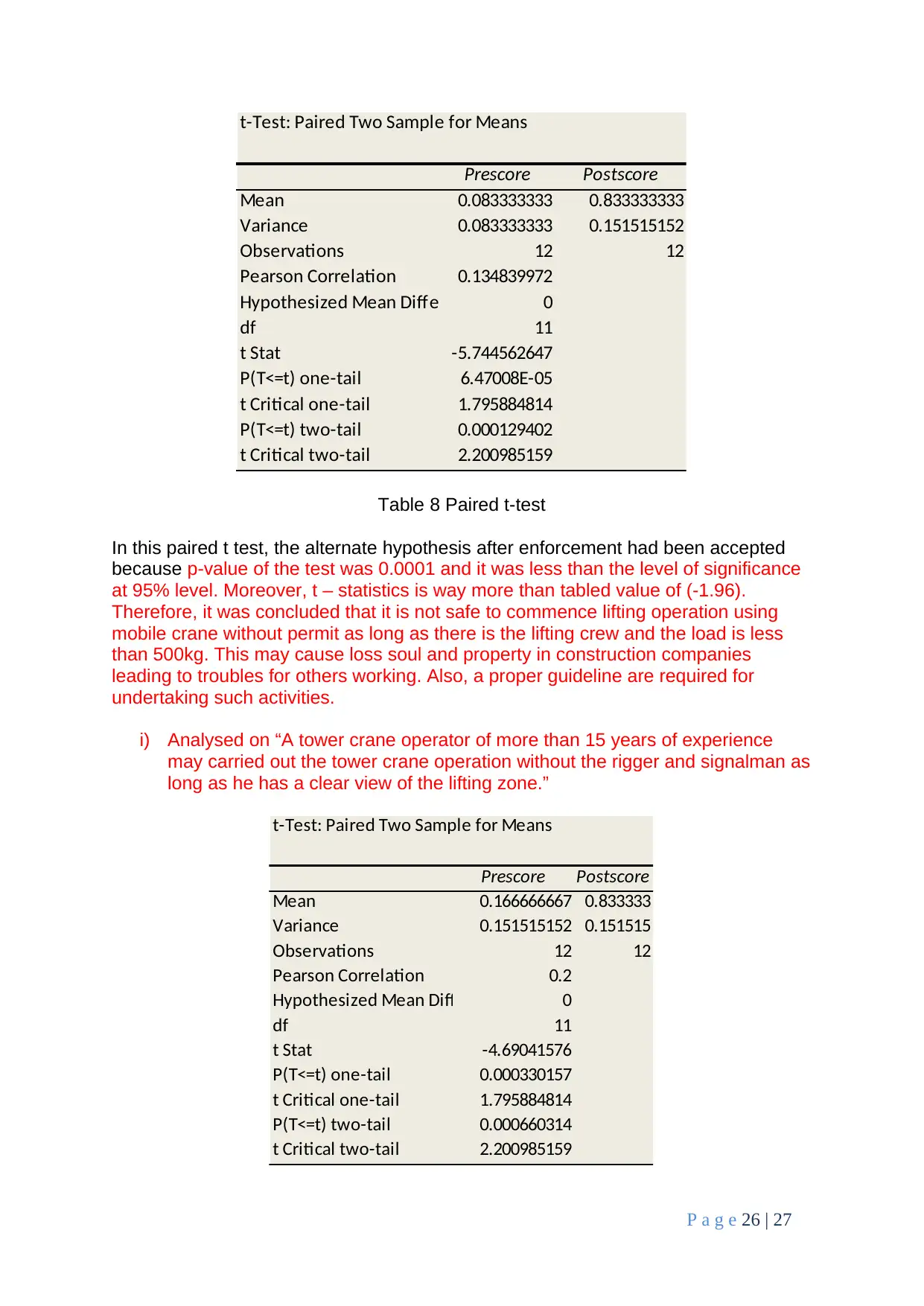
t-Test: Paired Two Sample for Means
Prescore Postscore
Mean 0.083333333 0.833333333
Variance 0.083333333 0.151515152
Observations 12 12
Pearson Correlation 0.134839972
Hypothesized Mean Difference 0
df 11
t Stat -5.744562647
P(T<=t) one-tail 6.47008E-05
t Critical one-tail 1.795884814
P(T<=t) two-tail 0.000129402
t Critical two-tail 2.200985159
Table 8 Paired t-test
In this paired t test, the alternate hypothesis after enforcement had been accepted
because p-value of the test was 0.0001 and it was less than the level of significance
at 95% level. Moreover, t – statistics is way more than tabled value of (-1.96).
Therefore, it was concluded that it is not safe to commence lifting operation using
mobile crane without permit as long as there is the lifting crew and the load is less
than 500kg. This may cause loss soul and property in construction companies
leading to troubles for others working. Also, a proper guideline are required for
undertaking such activities.
i) Analysed on “A tower crane operator of more than 15 years of experience
may carried out the tower crane operation without the rigger and signalman as
long as he has a clear view of the lifting zone.”
t-Test: Paired Two Sample for Means
Prescore Postscore
Mean 0.166666667 0.833333
Variance 0.151515152 0.151515
Observations 12 12
Pearson Correlation 0.2
Hypothesized Mean Difference 0
df 11
t Stat -4.69041576
P(T<=t) one-tail 0.000330157
t Critical one-tail 1.795884814
P(T<=t) two-tail 0.000660314
t Critical two-tail 2.200985159
P a g e 26 | 27
Prescore Postscore
Mean 0.083333333 0.833333333
Variance 0.083333333 0.151515152
Observations 12 12
Pearson Correlation 0.134839972
Hypothesized Mean Difference 0
df 11
t Stat -5.744562647
P(T<=t) one-tail 6.47008E-05
t Critical one-tail 1.795884814
P(T<=t) two-tail 0.000129402
t Critical two-tail 2.200985159
Table 8 Paired t-test
In this paired t test, the alternate hypothesis after enforcement had been accepted
because p-value of the test was 0.0001 and it was less than the level of significance
at 95% level. Moreover, t – statistics is way more than tabled value of (-1.96).
Therefore, it was concluded that it is not safe to commence lifting operation using
mobile crane without permit as long as there is the lifting crew and the load is less
than 500kg. This may cause loss soul and property in construction companies
leading to troubles for others working. Also, a proper guideline are required for
undertaking such activities.
i) Analysed on “A tower crane operator of more than 15 years of experience
may carried out the tower crane operation without the rigger and signalman as
long as he has a clear view of the lifting zone.”
t-Test: Paired Two Sample for Means
Prescore Postscore
Mean 0.166666667 0.833333
Variance 0.151515152 0.151515
Observations 12 12
Pearson Correlation 0.2
Hypothesized Mean Difference 0
df 11
t Stat -4.69041576
P(T<=t) one-tail 0.000330157
t Critical one-tail 1.795884814
P(T<=t) two-tail 0.000660314
t Critical two-tail 2.200985159
P a g e 26 | 27
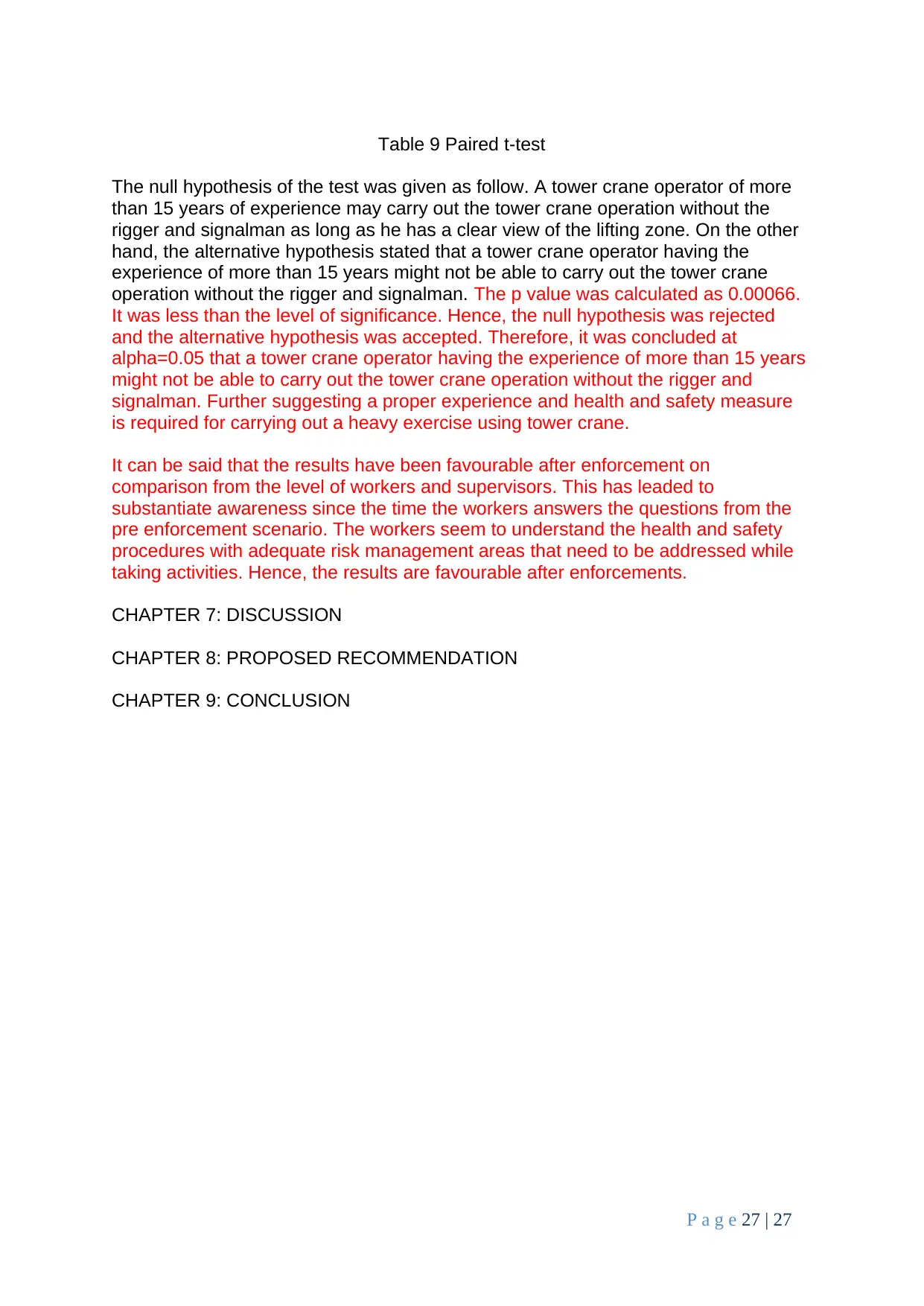
Table 9 Paired t-test
The null hypothesis of the test was given as follow. A tower crane operator of more
than 15 years of experience may carry out the tower crane operation without the
rigger and signalman as long as he has a clear view of the lifting zone. On the other
hand, the alternative hypothesis stated that a tower crane operator having the
experience of more than 15 years might not be able to carry out the tower crane
operation without the rigger and signalman. The p value was calculated as 0.00066.
It was less than the level of significance. Hence, the null hypothesis was rejected
and the alternative hypothesis was accepted. Therefore, it was concluded at
alpha=0.05 that a tower crane operator having the experience of more than 15 years
might not be able to carry out the tower crane operation without the rigger and
signalman. Further suggesting a proper experience and health and safety measure
is required for carrying out a heavy exercise using tower crane.
It can be said that the results have been favourable after enforcement on
comparison from the level of workers and supervisors. This has leaded to
substantiate awareness since the time the workers answers the questions from the
pre enforcement scenario. The workers seem to understand the health and safety
procedures with adequate risk management areas that need to be addressed while
taking activities. Hence, the results are favourable after enforcements.
CHAPTER 7: DISCUSSION
CHAPTER 8: PROPOSED RECOMMENDATION
CHAPTER 9: CONCLUSION
P a g e 27 | 27
The null hypothesis of the test was given as follow. A tower crane operator of more
than 15 years of experience may carry out the tower crane operation without the
rigger and signalman as long as he has a clear view of the lifting zone. On the other
hand, the alternative hypothesis stated that a tower crane operator having the
experience of more than 15 years might not be able to carry out the tower crane
operation without the rigger and signalman. The p value was calculated as 0.00066.
It was less than the level of significance. Hence, the null hypothesis was rejected
and the alternative hypothesis was accepted. Therefore, it was concluded at
alpha=0.05 that a tower crane operator having the experience of more than 15 years
might not be able to carry out the tower crane operation without the rigger and
signalman. Further suggesting a proper experience and health and safety measure
is required for carrying out a heavy exercise using tower crane.
It can be said that the results have been favourable after enforcement on
comparison from the level of workers and supervisors. This has leaded to
substantiate awareness since the time the workers answers the questions from the
pre enforcement scenario. The workers seem to understand the health and safety
procedures with adequate risk management areas that need to be addressed while
taking activities. Hence, the results are favourable after enforcements.
CHAPTER 7: DISCUSSION
CHAPTER 8: PROPOSED RECOMMENDATION
CHAPTER 9: CONCLUSION
P a g e 27 | 27
1 out of 27
Related Documents
Your All-in-One AI-Powered Toolkit for Academic Success.
+13062052269
info@desklib.com
Available 24*7 on WhatsApp / Email
![[object Object]](/_next/static/media/star-bottom.7253800d.svg)
Unlock your academic potential
© 2024 | Zucol Services PVT LTD | All rights reserved.




